|
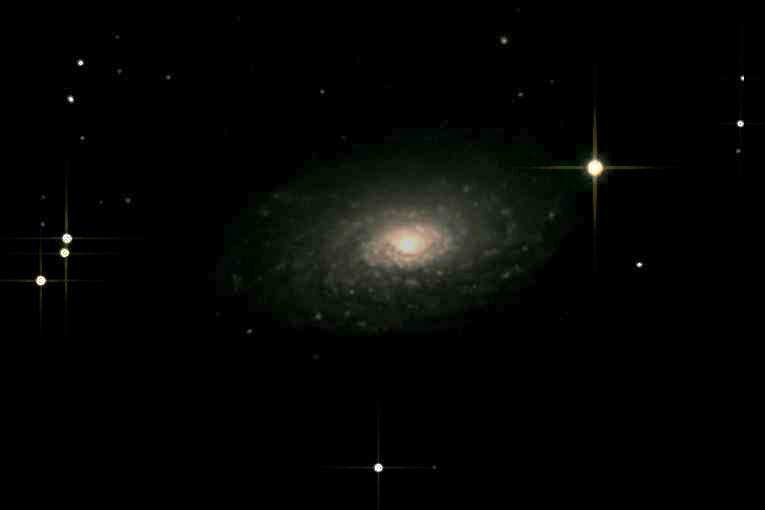 (24 May 2015) Messier 63 is a spiral galaxy in the constellation Canes Venatici. M63 consists of a central
disk surrounded by many spiral arm segments, oriented about 30° from an edge-on position.
At a distance of about 35 million light-years, the galaxy is about 100,000 light-years across. It's physically
associated with the nearby galaxy, M51 (also known as the Whirlpool Galaxy). This picture combines a
1 hour 15 minute black-and-white image with additional 18-minute red, green and blue images.
The original image scale is 1.14 arcsec per pixel.
(24 May 2015) Messier 63 is a spiral galaxy in the constellation Canes Venatici. M63 consists of a central
disk surrounded by many spiral arm segments, oriented about 30° from an edge-on position.
At a distance of about 35 million light-years, the galaxy is about 100,000 light-years across. It's physically
associated with the nearby galaxy, M51 (also known as the Whirlpool Galaxy). This picture combines a
1 hour 15 minute black-and-white image with additional 18-minute red, green and blue images.
The original image scale is 1.14 arcsec per pixel.
|
|
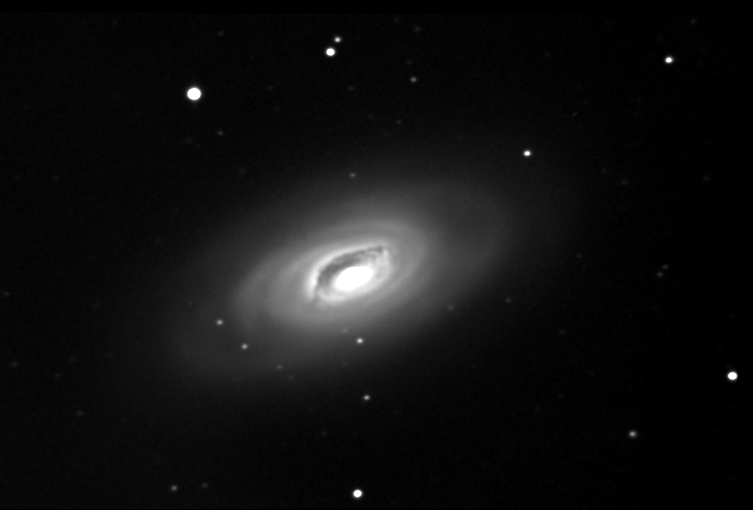 (19 May 2015) This picture combines 100 48-second exposures taken through Clear filter, for a total exposure
time of 1 hour 20 minutes. The images were aligned and stacked, and then contrast stretched. M64 is a barred
spiral (type Sb) located in the constellation of Coma Bernices and was first seen in 1779. M64 can be
glimpsed in a good pair of binoculars. The conspicuous dark structure is a dust feature
that obscures the light from the stars behind it. The original image scale is 1.14 arcsec
per pixel. Scroll down to 5 May 2008, to see another image of this galaxy.
(19 May 2015) This picture combines 100 48-second exposures taken through Clear filter, for a total exposure
time of 1 hour 20 minutes. The images were aligned and stacked, and then contrast stretched. M64 is a barred
spiral (type Sb) located in the constellation of Coma Bernices and was first seen in 1779. M64 can be
glimpsed in a good pair of binoculars. The conspicuous dark structure is a dust feature
that obscures the light from the stars behind it. The original image scale is 1.14 arcsec
per pixel. Scroll down to 5 May 2008, to see another image of this galaxy.
|
|
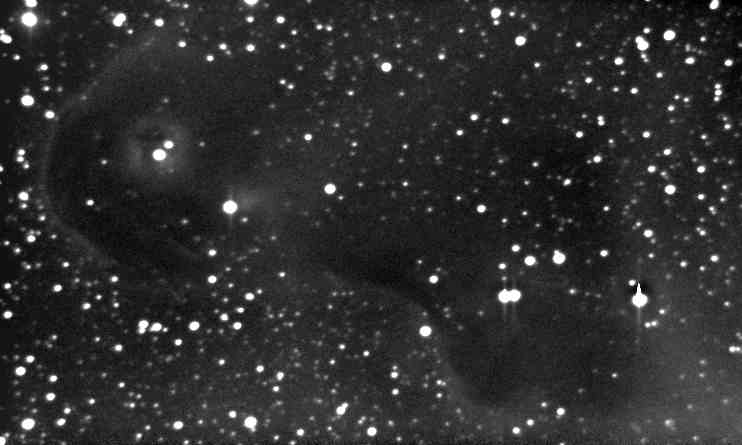 (6 October 2014) This picture combines 120 48-second exposures taken through Clear filter, for a total exposure
time of 1 hour 36 minutes. The images were aligned and stacked, and then contrast stretched. This giant emission
nebula is illuminated by very hot stars located near its center. The nebula is located in the constellation of Cepheus,
and is about 2,400 light-years away. The original image scale is 1.14 arcsec per pixel. Scroll down to 18 Sep 2007,
to see another image of this nebula.
(6 October 2014) This picture combines 120 48-second exposures taken through Clear filter, for a total exposure
time of 1 hour 36 minutes. The images were aligned and stacked, and then contrast stretched. This giant emission
nebula is illuminated by very hot stars located near its center. The nebula is located in the constellation of Cepheus,
and is about 2,400 light-years away. The original image scale is 1.14 arcsec per pixel. Scroll down to 18 Sep 2007,
to see another image of this nebula.
|
|
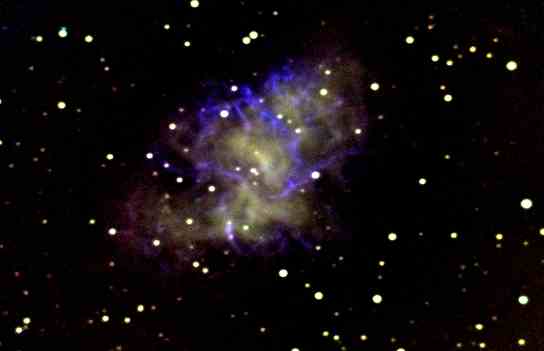 (28 September 2014) This picture combines a ten-minute exposure taken through Clear, H-alpha (red), Cousins-V (green)
and Blue filters. The Crab Nebula is located in the constellation of Taurus, and is about fifteen hundred
light-years away. The original image scale is 1.14 arcsec per pixel.
(28 September 2014) This picture combines a ten-minute exposure taken through Clear, H-alpha (red), Cousins-V (green)
and Blue filters. The Crab Nebula is located in the constellation of Taurus, and is about fifteen hundred
light-years away. The original image scale is 1.14 arcsec per pixel.
|
|
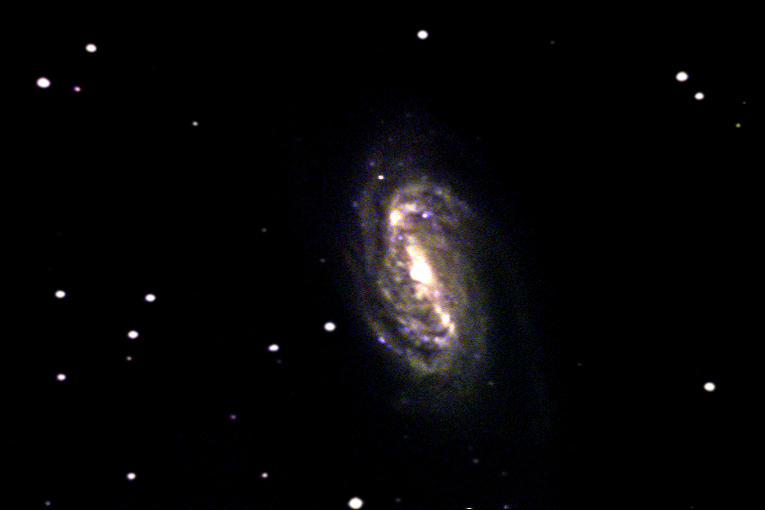 (28 February 2014) The last images of this were taken in March 2008. Since then I've merged the B&W image with new
RGB images taken now. This new image of NGC 2903, is made from 9-1/2 hours of guided exposures
through a clear filter. These were stacked and processed to improve contrast and reveal the wispy outer arms of this galaxy.
NGC 2903 is a barred spiral (type Sb) located in the constellation of Leo, and is about 31 million
light-years away. The original image scale is 1.27 arcsec per pixel.(See also
10 Mar 2008, below)
(28 February 2014) The last images of this were taken in March 2008. Since then I've merged the B&W image with new
RGB images taken now. This new image of NGC 2903, is made from 9-1/2 hours of guided exposures
through a clear filter. These were stacked and processed to improve contrast and reveal the wispy outer arms of this galaxy.
NGC 2903 is a barred spiral (type Sb) located in the constellation of Leo, and is about 31 million
light-years away. The original image scale is 1.27 arcsec per pixel.(See also
10 Mar 2008, below)
|
|
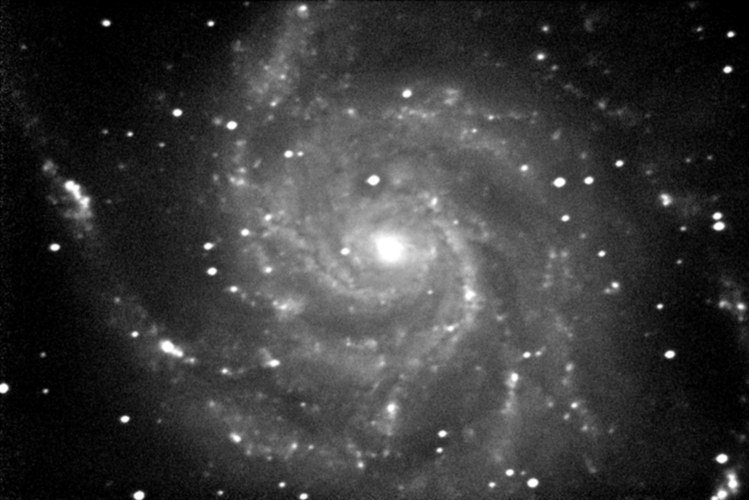 (28 February 2014) The Pinwheel Galaxy (M 101) is in the constellation of Ursa Major. At a distance of 21 million
light years, it is about 70% larger than our Milky Way Galaxy. All of the bright knots (in total more than 3000)
along the spiral arms are vigorous star forming regions of high-density molecular hydrogen gas. M 101 was
discovered in 1781 and is one of the last objects added to Charles Messier's original catalog. Total exposure
time was 90 minutes. The original image scale is 1.14 arcsec per pixel.
(28 February 2014) The Pinwheel Galaxy (M 101) is in the constellation of Ursa Major. At a distance of 21 million
light years, it is about 70% larger than our Milky Way Galaxy. All of the bright knots (in total more than 3000)
along the spiral arms are vigorous star forming regions of high-density molecular hydrogen gas. M 101 was
discovered in 1781 and is one of the last objects added to Charles Messier's original catalog. Total exposure
time was 90 minutes. The original image scale is 1.14 arcsec per pixel.
|
|
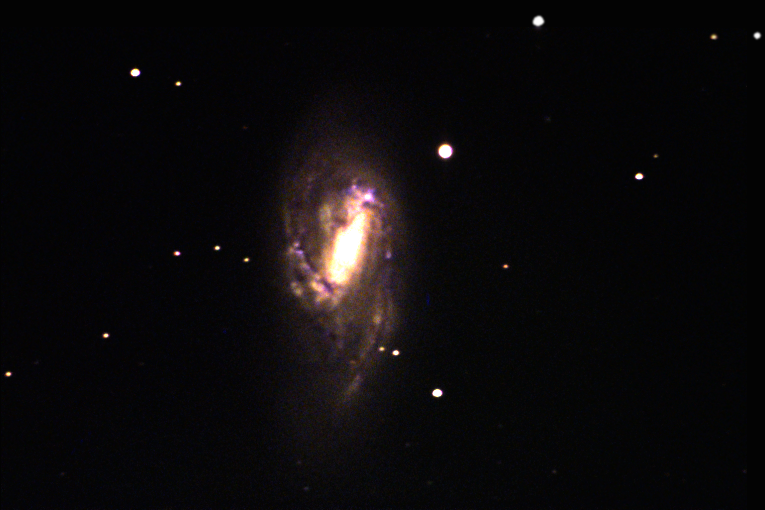 (28 February 2014) Placed at a distance of about 35 million light years, M66 is the largest of three interacting
galaxies called the Leo Triplet. Its spiral arms are asymmetric and seem to be displaced above the plane of the
galaxy. The core of the galaxy does not appear in its center. These distortions are most likely due to the gravitational
pull of the two companion galaxies. The pinkish areas are regions of active star formation. Total exposure time was 14 minutes
in each color (R,G,B) and 10 minutes for the B&W baseline image.
(28 February 2014) Placed at a distance of about 35 million light years, M66 is the largest of three interacting
galaxies called the Leo Triplet. Its spiral arms are asymmetric and seem to be displaced above the plane of the
galaxy. The core of the galaxy does not appear in its center. These distortions are most likely due to the gravitational
pull of the two companion galaxies. The pinkish areas are regions of active star formation. Total exposure time was 14 minutes
in each color (R,G,B) and 10 minutes for the B&W baseline image.
|
|
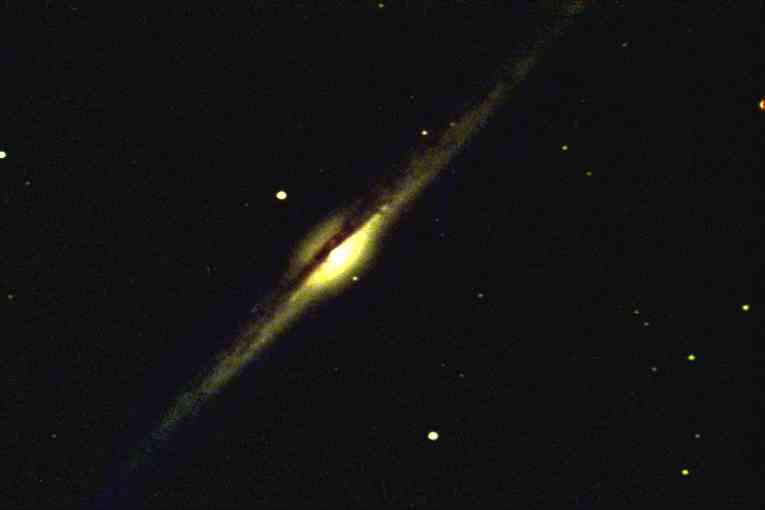 (28 February 2014) This edge-on spiral galaxy, not included in Charles Messier's famous catalog because he missed it, was first
noticed by Sir William Herschel in 1785. It is visible through a small telescope but too faint to see by eye. 15
two-minute exposures in each of three colors R, G, and B were stacked and then combined to form this color
representation. The bulging central core of NGC 4565 is cut in two by the obscuring dust that lies along
its spiral arms. At a distance of 40 million light years, it is about 100,000 light years across.
(28 February 2014) This edge-on spiral galaxy, not included in Charles Messier's famous catalog because he missed it, was first
noticed by Sir William Herschel in 1785. It is visible through a small telescope but too faint to see by eye. 15
two-minute exposures in each of three colors R, G, and B were stacked and then combined to form this color
representation. The bulging central core of NGC 4565 is cut in two by the obscuring dust that lies along
its spiral arms. At a distance of 40 million light years, it is about 100,000 light years across.
|
|
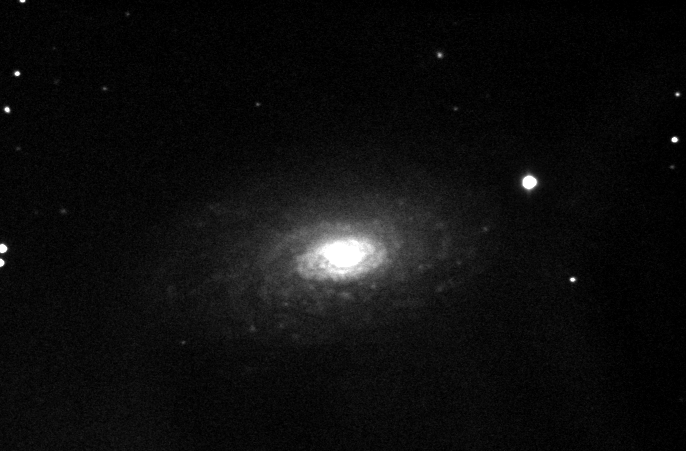 (24 April 2013) Messier's object no. 63 was first discovered by his assistant in 1779 and described as containing
no stars. In the intervening 240 years much more has been learned - particularly that the outer regions are
rotating so quickly that if it weren't for dark matter, the galaxy would rip itself apart. At a distance of 37 million
light-years, M 63 is about 135,000 light-years in diameter. It consists of a central disk surrounded by numerous
spiral arm segments. This is a 37-minute exposure.
(24 April 2013) Messier's object no. 63 was first discovered by his assistant in 1779 and described as containing
no stars. In the intervening 240 years much more has been learned - particularly that the outer regions are
rotating so quickly that if it weren't for dark matter, the galaxy would rip itself apart. At a distance of 37 million
light-years, M 63 is about 135,000 light-years in diameter. It consists of a central disk surrounded by numerous
spiral arm segments. This is a 37-minute exposure.
|
|
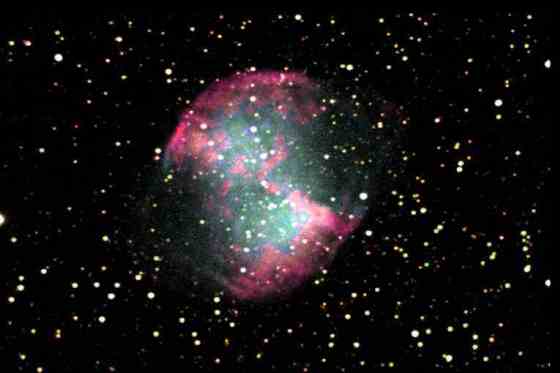 (21 April 2013) The Dumbbell Nebula (number 27 in Charles Messier's catalog) is classified as
a planetary nebula, but only because it appears round. It's really a gaseous emission cloud created
when the central star ran out of nuclear fuel and blew off its outer atmospheric layers. When it
was discovered in 1764, the physics and significance were well beyond 18th century science. This
10,000-14,000 year old nebula is about 1400 light-years from Earth. The total exposure time
in four parts of the color spectrum combined was about 17 minutes.
(21 April 2013) The Dumbbell Nebula (number 27 in Charles Messier's catalog) is classified as
a planetary nebula, but only because it appears round. It's really a gaseous emission cloud created
when the central star ran out of nuclear fuel and blew off its outer atmospheric layers. When it
was discovered in 1764, the physics and significance were well beyond 18th century science. This
10,000-14,000 year old nebula is about 1400 light-years from Earth. The total exposure time
in four parts of the color spectrum combined was about 17 minutes.
|
|
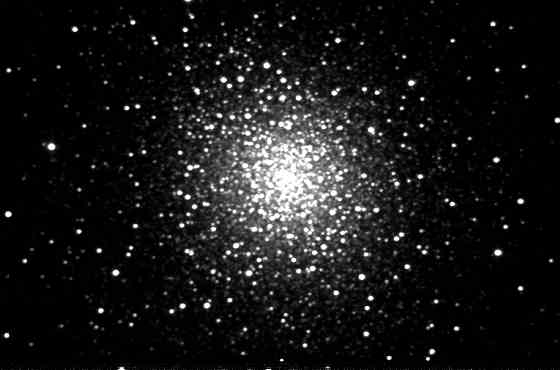 (21 April 2013) M92 is a bright globular cluster located in the direction of the constellation of Hercules.
Discovered in the 18th century, and overshadowed by the more spectacular M13, it is about 26,700
light-years from Earth and has a diameter of about 220 light-years. The estimated age of the 330,000
stars in M92 is 14.2 billion years. 120 48-second exposures (total 100 minutes) were aligned and
stacked to produce this image.
(21 April 2013) M92 is a bright globular cluster located in the direction of the constellation of Hercules.
Discovered in the 18th century, and overshadowed by the more spectacular M13, it is about 26,700
light-years from Earth and has a diameter of about 220 light-years. The estimated age of the 330,000
stars in M92 is 14.2 billion years. 120 48-second exposures (total 100 minutes) were aligned and
stacked to produce this image.
|
|
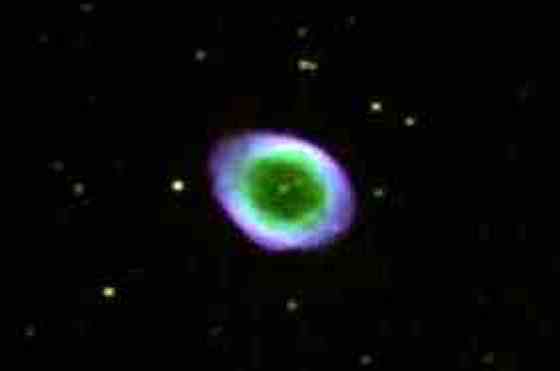 (14 April 2013) After a long hiatus due to disabled equipment, bad weather and laziness, everything
is back in working order. This color image of the Ring Nebula (M57) is a composite of 15 images each
in Blue, V (green), and R (red). Total exposure is 22 minutes. At the distance of the nebula, estimated
to be about 2,300 light-years, the size of the nebula is about 2.6 light years across, and it is expanding at
a rate of 20-30 km per second.
(14 April 2013) After a long hiatus due to disabled equipment, bad weather and laziness, everything
is back in working order. This color image of the Ring Nebula (M57) is a composite of 15 images each
in Blue, V (green), and R (red). Total exposure is 22 minutes. At the distance of the nebula, estimated
to be about 2,300 light-years, the size of the nebula is about 2.6 light years across, and it is expanding at
a rate of 20-30 km per second.
|
|
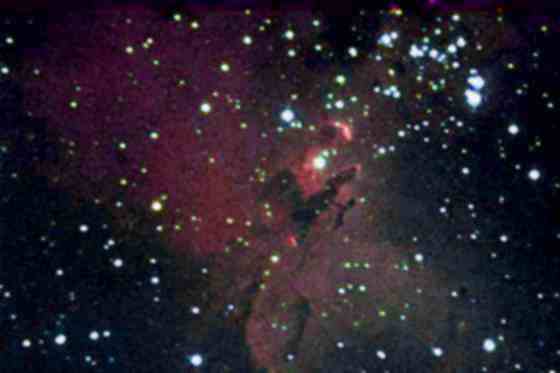 (6 April 2013) Fifteen 30-second images each of M16/IC 4703 through Blue, V and R filters (22-1/2 minutes
altogether) were stacked to produce this false-color image. The image was contrast-stretched and
hue-adjusted to bring out the details. The Eagle Nebula, as IC 4703 is also known, embraces a swarm
of young stars (M16) about 5-1/2 million years old, at a distance of 7,000 light years. The star cluster is
about 15 light-years across, and the nebula is 70 light-years across at its widest.
(6 April 2013) Fifteen 30-second images each of M16/IC 4703 through Blue, V and R filters (22-1/2 minutes
altogether) were stacked to produce this false-color image. The image was contrast-stretched and
hue-adjusted to bring out the details. The Eagle Nebula, as IC 4703 is also known, embraces a swarm
of young stars (M16) about 5-1/2 million years old, at a distance of 7,000 light years. The star cluster is
about 15 light-years across, and the nebula is 70 light-years across at its widest.
|
|
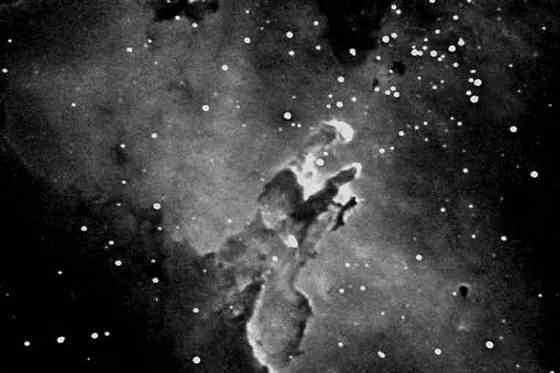 (6 April 2013) Fifteen 30-second images of M16/IC 4703 through a Blue filter were stacked to
produce this image. The image was contrast-stretched to bring out the details. M 16 is a great cloud of
interstellar gas. The tower of gas coming off the nebula is about 9-1/2 light-years or about 90 trillion
kilometers high. The Hubble photographs of this nebula call this tower the "Pillars of Creation."
The knots and denser gas in the columns act as incubators for new stars.
(6 April 2013) Fifteen 30-second images of M16/IC 4703 through a Blue filter were stacked to
produce this image. The image was contrast-stretched to bring out the details. M 16 is a great cloud of
interstellar gas. The tower of gas coming off the nebula is about 9-1/2 light-years or about 90 trillion
kilometers high. The Hubble photographs of this nebula call this tower the "Pillars of Creation."
The knots and denser gas in the columns act as incubators for new stars.
|
|
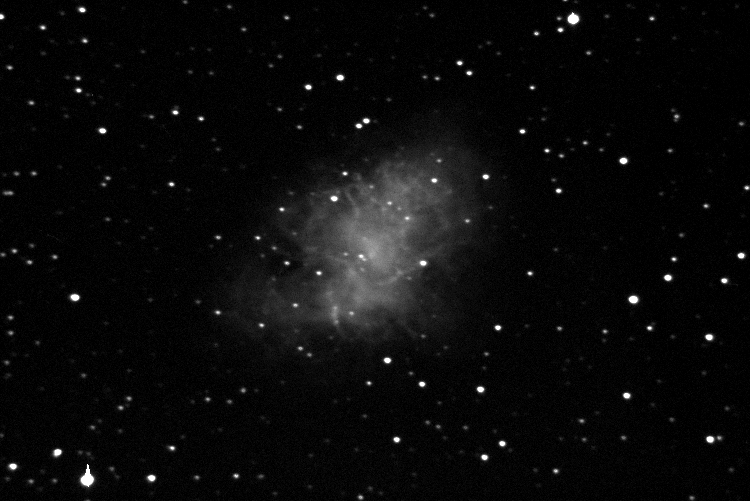 (16 January 2012) Quite a bit of serendipity! The asteroid 3724 Annenskij was moving in retrograde
motion in front of the Crab Nebula as I was taking these images. There are eight frames of 60
second exposures compiled into an animation of about two seconds in total. Annenskij, 14 km in diameter, is at
opposition and moving to the west in the sky, at a distance of about 1.64 astronomical units from
Earth. It was discovered in 1979, but it can been seen on photographs taken as early as 1933. The
image immediately below stacks the eight images, and so Annenskij is a streak.
(16 January 2012) Quite a bit of serendipity! The asteroid 3724 Annenskij was moving in retrograde
motion in front of the Crab Nebula as I was taking these images. There are eight frames of 60
second exposures compiled into an animation of about two seconds in total. Annenskij, 14 km in diameter, is at
opposition and moving to the west in the sky, at a distance of about 1.64 astronomical units from
Earth. It was discovered in 1979, but it can been seen on photographs taken as early as 1933. The
image immediately below stacks the eight images, and so Annenskij is a streak.
|
|
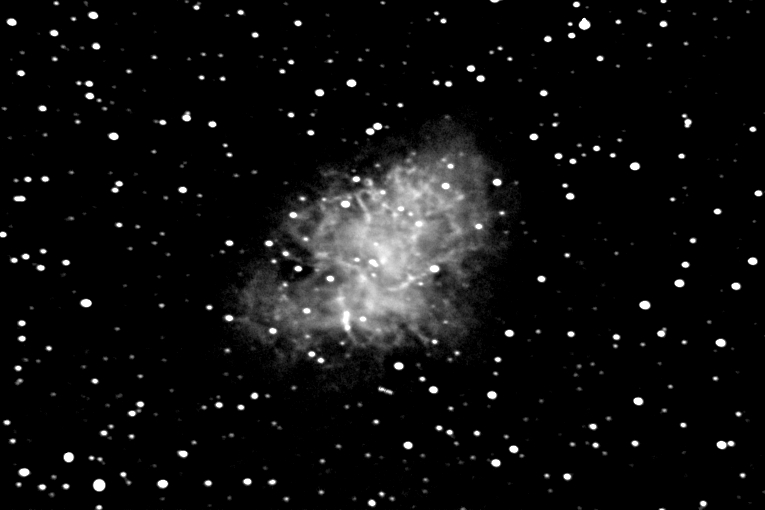 (16 January 2012) Eight images of the Crab Nebula were taken at 60 seconds apiece and stacked to
produce this composite view. The streak to the south of the nebula is the main-belt asteroid, 3724 Annenskij,
at visual magnitude 15.3. Annenskij takes 1677 days (4.59 years) to orbit the Sun.
(16 January 2012) Eight images of the Crab Nebula were taken at 60 seconds apiece and stacked to
produce this composite view. The streak to the south of the nebula is the main-belt asteroid, 3724 Annenskij,
at visual magnitude 15.3. Annenskij takes 1677 days (4.59 years) to orbit the Sun.
|
|
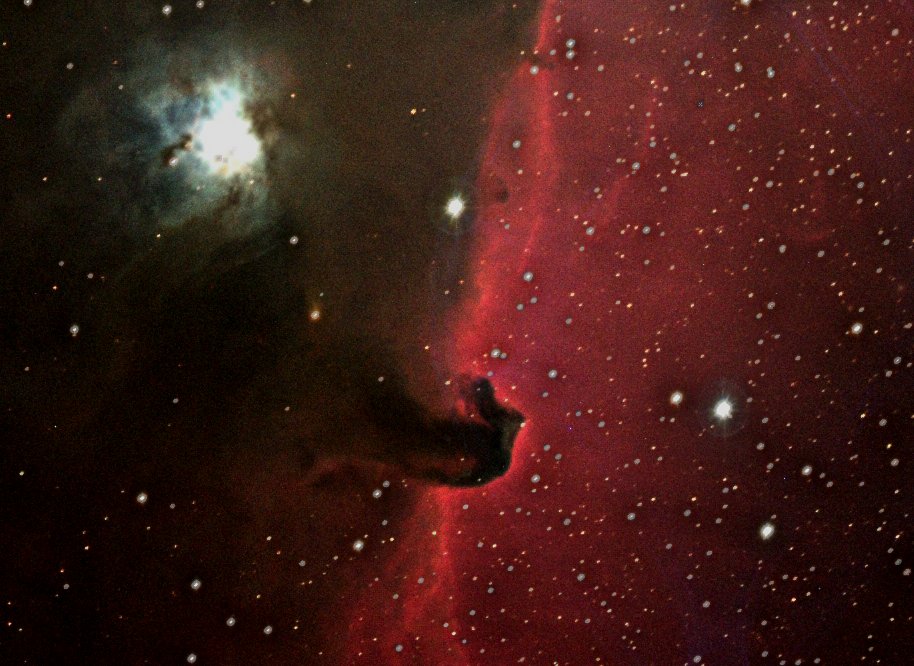 (18 January 2010) Inspired by another photograph of the the Horsehead Nebula I saw recently,
I reprocessed the 15-minute exposure image taken by remote control at the Reynold's Meehan Observatory,
located in San Pedro de Atacama, Chile on 18 Jan 2010. The original image, shown farther down,
has a lot of detail that doesn't appear in the full image. I cropped out a section of that image that
is reproduced here at a 2:1 scale (4 pixels in the original image combined into 1 pixel on the screen).
(18 January 2010) Inspired by another photograph of the the Horsehead Nebula I saw recently,
I reprocessed the 15-minute exposure image taken by remote control at the Reynold's Meehan Observatory,
located in San Pedro de Atacama, Chile on 18 Jan 2010. The original image, shown farther down,
has a lot of detail that doesn't appear in the full image. I cropped out a section of that image that
is reproduced here at a 2:1 scale (4 pixels in the original image combined into 1 pixel on the screen).
|
|
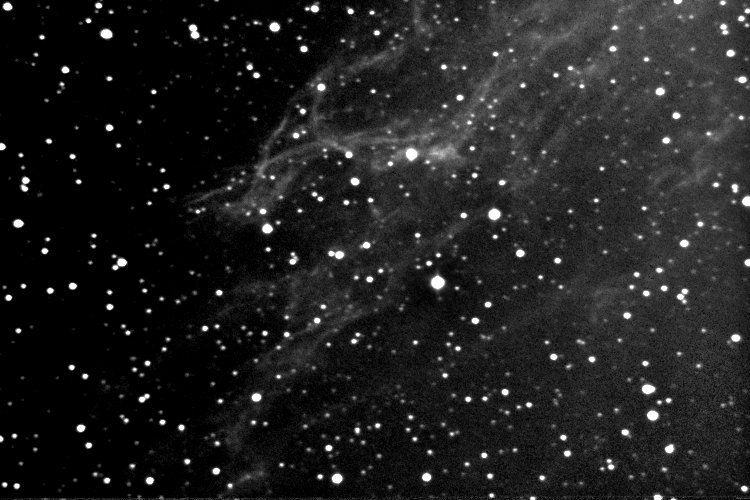 (23 October 2011) This image of the Veil Nebula is a stack of eight 60-second exposures (8 minutes total).
The image was sharpened and contrast stretched. The original scale is 1.14 arcsec per pixel.
The Veil Nebula constitutes the visual portion of the "Cygnus Loop," which is the remnant of a
supernova 1,500 light-years from Earth that exploded in our Mikly Way Galaxy between 5,000 and
8,000 years ago, in the constellation of Cygnus. This image is a very small portion of the Eastern
Veil (NGC 6992). At this scale, it would take 36 images to cover the whole loop, and in the sky
it would look six time the diameter of the Moon.
(23 October 2011) This image of the Veil Nebula is a stack of eight 60-second exposures (8 minutes total).
The image was sharpened and contrast stretched. The original scale is 1.14 arcsec per pixel.
The Veil Nebula constitutes the visual portion of the "Cygnus Loop," which is the remnant of a
supernova 1,500 light-years from Earth that exploded in our Mikly Way Galaxy between 5,000 and
8,000 years ago, in the constellation of Cygnus. This image is a very small portion of the Eastern
Veil (NGC 6992). At this scale, it would take 36 images to cover the whole loop, and in the sky
it would look six time the diameter of the Moon.
|
|
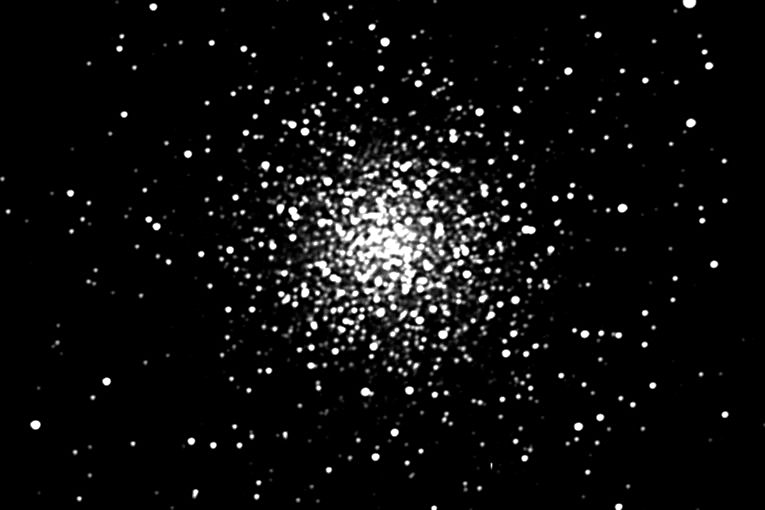 (27 March 2011) The image is 60 minutes total exposure (12 times 5 minutes).
The images were stacked, sharpened and contrast stretched. The original
scale was 1.14 arcsec per pixel. Click here to look at
a "movie" showing the RR Lyrae variable stars in M3, posted on 22 Apr 2007.
(27 March 2011) The image is 60 minutes total exposure (12 times 5 minutes).
The images were stacked, sharpened and contrast stretched. The original
scale was 1.14 arcsec per pixel. Click here to look at
a "movie" showing the RR Lyrae variable stars in M3, posted on 22 Apr 2007.
|
|
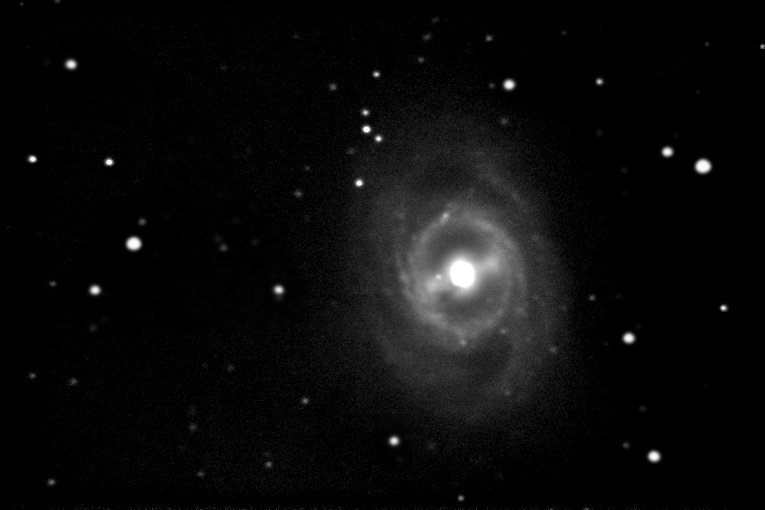 (13 March 2011) Recent measurements using the Hubble Space Telescope put the distance to
this beautiful barred spiral galaxy, M95 (NGC3351), at 35.5 million light years. Surrounding the
nucleus of this galaxy is a ring-shaped star-forming region with a diameter
of about 2000 light years. This pretty galaxy was first seen in 1781, and cataloged by Charles
Messier as a "nebula without star, in the Lion." A telescope and reasonably dark skies are
needed to observe this galaxy by eye. The image is 135 minutes total exposure
(19 times 5 minutes). The images were stacked, sharpened and contrast stretched. The original
scale was 1.14 arcsec per pixel.
(13 March 2011) Recent measurements using the Hubble Space Telescope put the distance to
this beautiful barred spiral galaxy, M95 (NGC3351), at 35.5 million light years. Surrounding the
nucleus of this galaxy is a ring-shaped star-forming region with a diameter
of about 2000 light years. This pretty galaxy was first seen in 1781, and cataloged by Charles
Messier as a "nebula without star, in the Lion." A telescope and reasonably dark skies are
needed to observe this galaxy by eye. The image is 135 minutes total exposure
(19 times 5 minutes). The images were stacked, sharpened and contrast stretched. The original
scale was 1.14 arcsec per pixel.
|
|
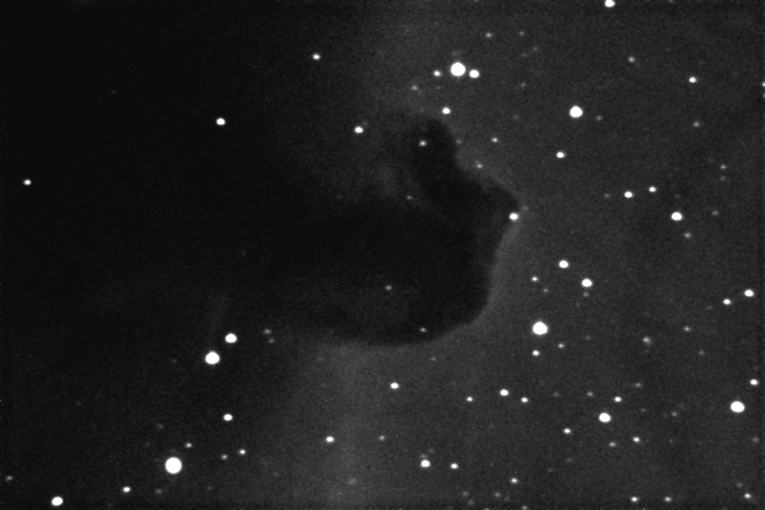 (12 February 2011) This image of the Horsehead Nebula (Barnard 33 blocking the light from IC 434) is a
composite of five 5-minute exposures, stacked, sharpened and contrast stretched. B33 is about
1600 light years from Earth. The faint dark circular arc on the right side of the image is an artifact.
The original scale was 1.14 arcsec per pixel.
(12 February 2011) This image of the Horsehead Nebula (Barnard 33 blocking the light from IC 434) is a
composite of five 5-minute exposures, stacked, sharpened and contrast stretched. B33 is about
1600 light years from Earth. The faint dark circular arc on the right side of the image is an artifact.
The original scale was 1.14 arcsec per pixel.
|
|
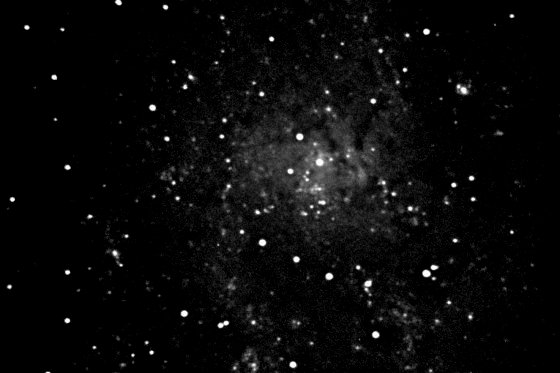 (9 January 2011) This image of M-33, sometimes called the Triangulum Galaxy, is the third-largest
member of the Local Group of galaxies, which includes our Milky Way Galaxy and the Andromeda
Galaxy. In dark skies away from rural lights, M33 can be easily seen with the naked eye. It
was noted by an Italian astronomer in 1654. Today, the Hubble Space Telescope reveals
many interesting gas clouds and stars in this galaxy, 3 million light years away. This image is a single 200
second exposure that has been sharpened and contrast stretched. It shows the central third
of the galaxy's structure. The original scale was 1.14 arcsec per pixel.
(9 January 2011) This image of M-33, sometimes called the Triangulum Galaxy, is the third-largest
member of the Local Group of galaxies, which includes our Milky Way Galaxy and the Andromeda
Galaxy. In dark skies away from rural lights, M33 can be easily seen with the naked eye. It
was noted by an Italian astronomer in 1654. Today, the Hubble Space Telescope reveals
many interesting gas clouds and stars in this galaxy, 3 million light years away. This image is a single 200
second exposure that has been sharpened and contrast stretched. It shows the central third
of the galaxy's structure. The original scale was 1.14 arcsec per pixel.
|
|
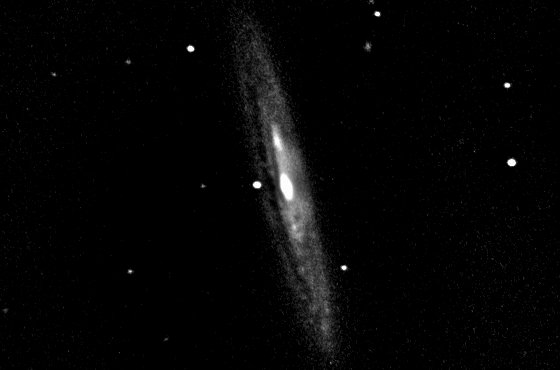 (1 May 2010) Located near the center of the Virgo Cluster of galaxies, about 40 million light-years away,
is this barred spiral galaxy, NGC 4216, seen almost edge-on. In 1917, astronomer Francis Pease called
NGC 4216 "a left-handed spiral," and it's one of the 400 "extra-galactic nebulae" Edwin Hubble
included in his seminal paper (1926) developing the classification system for galaxies used today.
This image is composed from 19 3-minute exposures that have been stacked and contrast stretched.
The original scale was 1.14 arcsec per pixel.
(1 May 2010) Located near the center of the Virgo Cluster of galaxies, about 40 million light-years away,
is this barred spiral galaxy, NGC 4216, seen almost edge-on. In 1917, astronomer Francis Pease called
NGC 4216 "a left-handed spiral," and it's one of the 400 "extra-galactic nebulae" Edwin Hubble
included in his seminal paper (1926) developing the classification system for galaxies used today.
This image is composed from 19 3-minute exposures that have been stacked and contrast stretched.
The original scale was 1.14 arcsec per pixel.
|
|
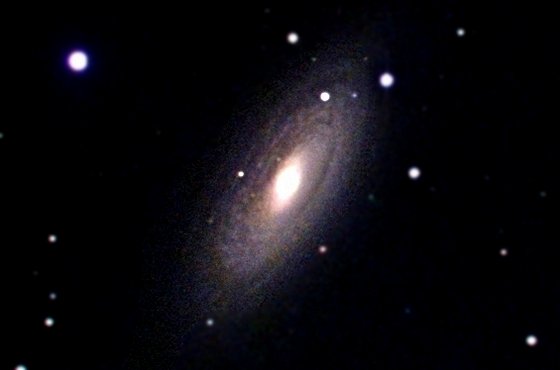 (09 March 2010) This image of NGC 2841, in Ursa Major, is the same image as below, but colorized by including
three images taken through I (15 minute exposure), R (10 minute) and V filters (5 minute)
and displayed in false color as R, G and B, respectively, along with the luminance image below. I,R,V
filters do not accurately model color vision, so it's not possible to create a faithful rendering
of this image in true color. The original scale of the I,R,V images is 2.29 arcsec per pixel.
Compare this with the beautiful picture here.
(09 March 2010) This image of NGC 2841, in Ursa Major, is the same image as below, but colorized by including
three images taken through I (15 minute exposure), R (10 minute) and V filters (5 minute)
and displayed in false color as R, G and B, respectively, along with the luminance image below. I,R,V
filters do not accurately model color vision, so it's not possible to create a faithful rendering
of this image in true color. The original scale of the I,R,V images is 2.29 arcsec per pixel.
Compare this with the beautiful picture here.
|
|
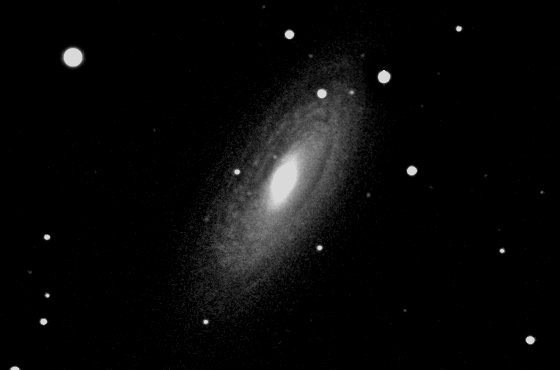 (09 March 2010) NGC 2841 is a tightly-wound spiral galaxy in the constellation of Ursa Major, some 46 million
million light-years away. At this distance, the diameter of NGC 2841 must be about 150,000 light-years. The
galaxy's dust lanes and turbulent star-forming regions are plainly visible. Three supernovae have exploded and been
seen in this galaxy since 1912. Sixteen exposures of 5 minutes duration each were stacked to get this image. The
original image scale is 1.14 arcsec per pixel.
(09 March 2010) NGC 2841 is a tightly-wound spiral galaxy in the constellation of Ursa Major, some 46 million
million light-years away. At this distance, the diameter of NGC 2841 must be about 150,000 light-years. The
galaxy's dust lanes and turbulent star-forming regions are plainly visible. Three supernovae have exploded and been
seen in this galaxy since 1912. Sixteen exposures of 5 minutes duration each were stacked to get this image. The
original image scale is 1.14 arcsec per pixel.
|
|
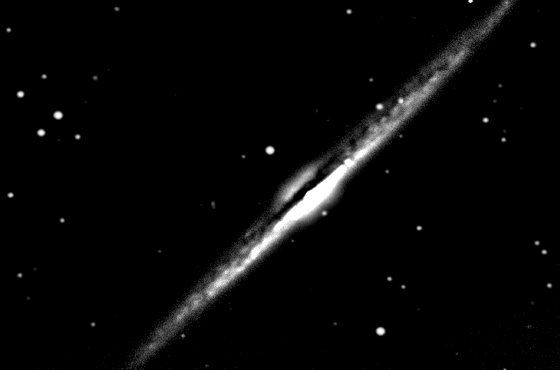 (09 March 2010) This image of NGC 4565 is a stack of 24 5-minutes exposures, for a total of 120 minutes.
NGC 4565 is an edge-on spiral galaxy approximately 30 million light-years distant from Earth, in the direction of
the constellation of Coma Berenices. It's bright enough to be seen in a small telescope from a dark sky location.
Much like our own Milky Way Galaxy, though viewed edge-on, we see the obscuring lane of gas and dust that blocks the light
from the interior. It is said that Sir William Herschel first saw this galaxy in 1785. The image scale is 1.14 arcsec per pixel.
(09 March 2010) This image of NGC 4565 is a stack of 24 5-minutes exposures, for a total of 120 minutes.
NGC 4565 is an edge-on spiral galaxy approximately 30 million light-years distant from Earth, in the direction of
the constellation of Coma Berenices. It's bright enough to be seen in a small telescope from a dark sky location.
Much like our own Milky Way Galaxy, though viewed edge-on, we see the obscuring lane of gas and dust that blocks the light
from the interior. It is said that Sir William Herschel first saw this galaxy in 1785. The image scale is 1.14 arcsec per pixel.
|
|
 (06 February 2010) This little known optical binary systems, Θ¹ and Θ² Effundo Majoris, is
located at a distance of approximately 30 million micrometers, in the direction of the north
geographic pole. At this distance the system measures about 5 million micrometers across. The system
is embedded in heavily-obscuring clouds of molecular water ice. It's not known whether this system
harbors life, but on occasion periodic electromagnetic radiation has been detected emanating from the secondary
at a frequency of 2.4 GHz. This image is a single 1/30 second exposure.
(06 February 2010) This little known optical binary systems, Θ¹ and Θ² Effundo Majoris, is
located at a distance of approximately 30 million micrometers, in the direction of the north
geographic pole. At this distance the system measures about 5 million micrometers across. The system
is embedded in heavily-obscuring clouds of molecular water ice. It's not known whether this system
harbors life, but on occasion periodic electromagnetic radiation has been detected emanating from the secondary
at a frequency of 2.4 GHz. This image is a single 1/30 second exposure.
|
|
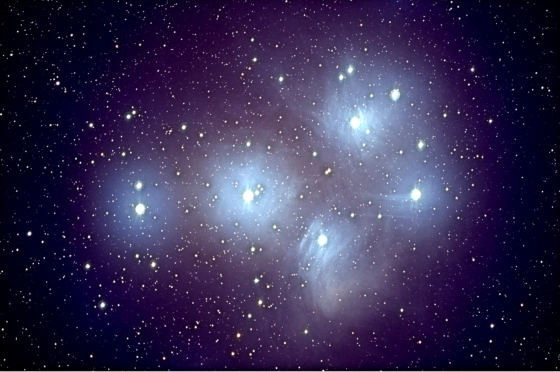 (18 January 2010) This diaphanous cluster of stars lies at a distance of about 440 light-years
from the Earth, in the constellation of Taurus, the bull. The Pleiades contain over a thousand
confirmed members, most of them hot blue stars. The nine brightest stars in the Pleiades are named for
the Seven Sisters of Greek mythology - Sterope, Merope, Electra, Maia, Taygete, Celaeno, and Alcyone,
and their parents - Atlas and Pleione. This image is a single five-minutes exposure.
(18 January 2010) This diaphanous cluster of stars lies at a distance of about 440 light-years
from the Earth, in the constellation of Taurus, the bull. The Pleiades contain over a thousand
confirmed members, most of them hot blue stars. The nine brightest stars in the Pleiades are named for
the Seven Sisters of Greek mythology - Sterope, Merope, Electra, Maia, Taygete, Celaeno, and Alcyone,
and their parents - Atlas and Pleione. This image is a single five-minutes exposure.
|
|
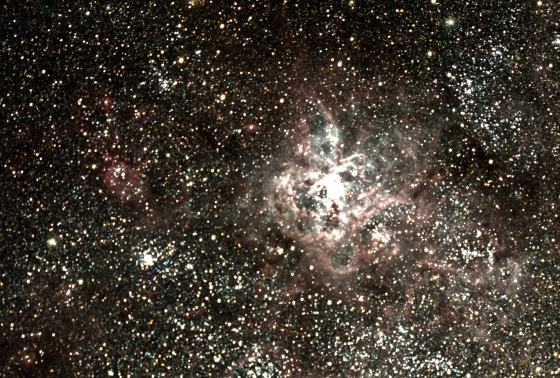 (18 January 2010) This pretty object is called the Tarantula Nebula because of its fuzzy,
spider-like "legs." The nebula is the largest emission nebula known. It's located at the eastern
end of the nearby galaxy we call the Large Magellanic Cloud. At a distance of 170,000 light-years,
in the southern constellation Dorado, it is a complex, monstrous stellar nursery. If you
could see the nebula with the naked eye, it would be almost as big as the size of the full Moon.
This is one ten-minutes exposure.
(18 January 2010) This pretty object is called the Tarantula Nebula because of its fuzzy,
spider-like "legs." The nebula is the largest emission nebula known. It's located at the eastern
end of the nearby galaxy we call the Large Magellanic Cloud. At a distance of 170,000 light-years,
in the southern constellation Dorado, it is a complex, monstrous stellar nursery. If you
could see the nebula with the naked eye, it would be almost as big as the size of the full Moon.
This is one ten-minutes exposure.
|
|
 (18 January 2010) Another barred spiral galaxy, NGC 2442, is located near the south celestial pole,
in the Southern constellation of Volans. It's a rather small galaxy and highly distorted,
most likely the result of an encounter with another galaxy in the past (the one on the left?).
Located about 50 million light years away, it's only 75,000 light years across. Star forming
regions are prevalent throughout the arms. This image is a stack of three 10-minute exposure.
The original image scale is 2.38 arcsec per pixel.
(18 January 2010) Another barred spiral galaxy, NGC 2442, is located near the south celestial pole,
in the Southern constellation of Volans. It's a rather small galaxy and highly distorted,
most likely the result of an encounter with another galaxy in the past (the one on the left?).
Located about 50 million light years away, it's only 75,000 light years across. Star forming
regions are prevalent throughout the arms. This image is a stack of three 10-minute exposure.
The original image scale is 2.38 arcsec per pixel.
|
|
 (18 January 2010) NGC 1365 is a barred spiral galaxy located in the Southern constellation of
Fornax (the furnace). Located about 60 million light years away, it's about 200,000 light years
across. From our viewpoint, this spiral rotates clockwise once around every 350 million years.
The five-minute exposure shown here was taken by remote control at the Reynold's Meehan
Observatory, in Chile. The original image scale is 2.38 arcsec per pixel.
(18 January 2010) NGC 1365 is a barred spiral galaxy located in the Southern constellation of
Fornax (the furnace). Located about 60 million light years away, it's about 200,000 light years
across. From our viewpoint, this spiral rotates clockwise once around every 350 million years.
The five-minute exposure shown here was taken by remote control at the Reynold's Meehan
Observatory, in Chile. The original image scale is 2.38 arcsec per pixel.
|
|
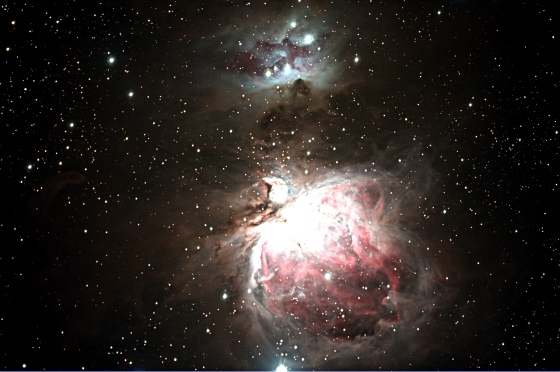 (18 January 2010) This 5 minute exposure of M42, the Orion Nebulae, and M43 to the north was
taken by remote control at the Reynold's Meehan Observatory, in Chile. In the very center would be
the Trapezium. The original image scale is 2.38 arcsec per pixel. Many thanks to
Andy Blanchard (Oakville, Ontario) for allowing me to use his telescope in Chile - it's awesome.
(18 January 2010) This 5 minute exposure of M42, the Orion Nebulae, and M43 to the north was
taken by remote control at the Reynold's Meehan Observatory, in Chile. In the very center would be
the Trapezium. The original image scale is 2.38 arcsec per pixel. Many thanks to
Andy Blanchard (Oakville, Ontario) for allowing me to use his telescope in Chile - it's awesome.
|
|
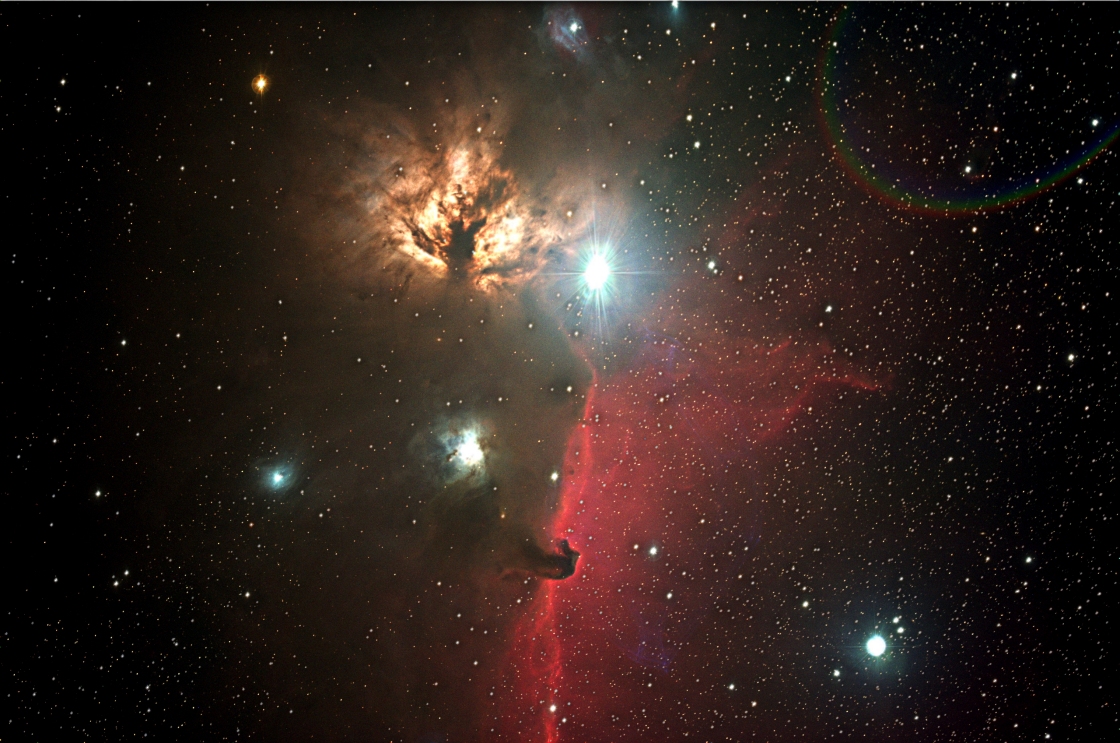 (18 January 2010) Here is a 15 minute exposure of the Horsehead and Flame nebulae seen below,
taken by remote control at the Reynold's Meehan Observatory.
Because of the longer exposure for this image, the "real" colors come out. These
nebulae are about 1500 light-years from us. The bright star above center is
the easternmost star in Orion's belt. This region is part of a larger cloud that covers
most of the constellation of Orion. The dark cloud that produces the horse head and flame
nebulae also obscures the stars that lie behind it. The original image scale is 2.38
arcsec per pixel.
(18 January 2010) Here is a 15 minute exposure of the Horsehead and Flame nebulae seen below,
taken by remote control at the Reynold's Meehan Observatory.
Because of the longer exposure for this image, the "real" colors come out. These
nebulae are about 1500 light-years from us. The bright star above center is
the easternmost star in Orion's belt. This region is part of a larger cloud that covers
most of the constellation of Orion. The dark cloud that produces the horse head and flame
nebulae also obscures the stars that lie behind it. The original image scale is 2.38
arcsec per pixel.
|
|
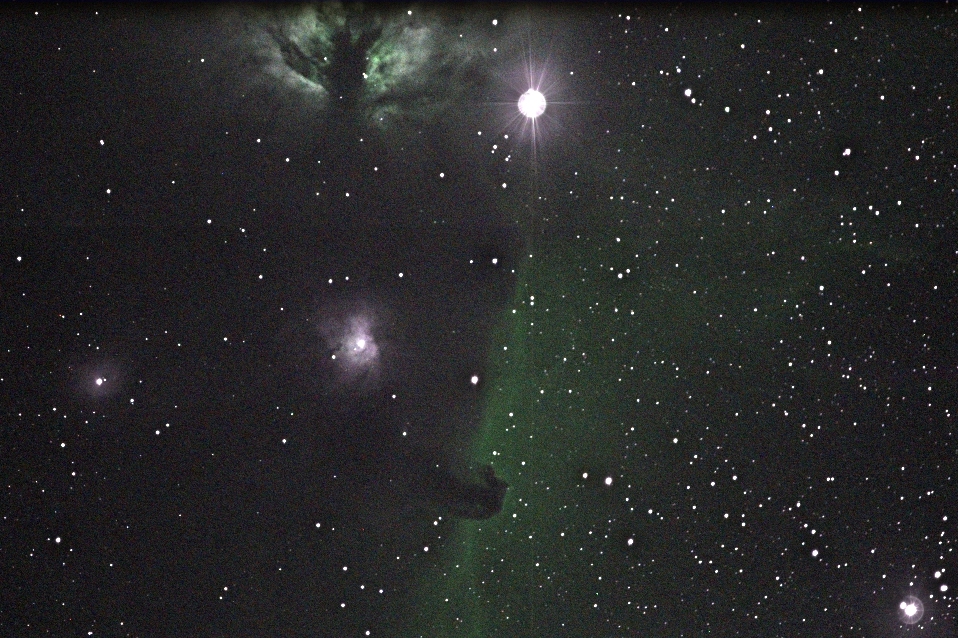 (18 January 2010) This eerie image is just one 30 second exposure of the Horsehead and
Flame nebulae, taken by remote control at the
Reynold's Meehan Observatory, located in San Pedro de Atacama, Chile. The observatory is at
~2,450 meters elevation.The telescope is a 14-inch Schmidt-Cassegrain, with a 6 Mpx
one-shot color camera attached. The field of view covers about 2 degree x 1½ degrees. It takes 64
BrightSkies images to cover the same area. The original image scale is 2.38 arcsec per pixel.
(18 January 2010) This eerie image is just one 30 second exposure of the Horsehead and
Flame nebulae, taken by remote control at the
Reynold's Meehan Observatory, located in San Pedro de Atacama, Chile. The observatory is at
~2,450 meters elevation.The telescope is a 14-inch Schmidt-Cassegrain, with a 6 Mpx
one-shot color camera attached. The field of view covers about 2 degree x 1½ degrees. It takes 64
BrightSkies images to cover the same area. The original image scale is 2.38 arcsec per pixel.
|
|
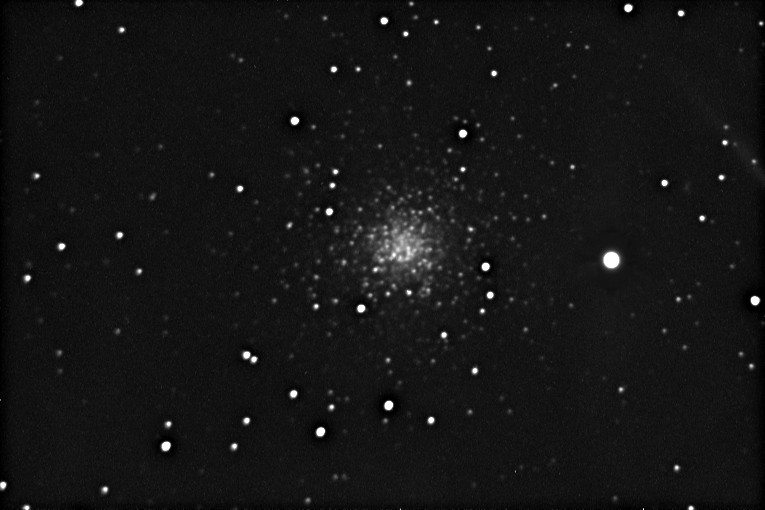 (20 October 2009) This is a new 100-minute unfiltered exposure (20 x 5') of one of my favorite objects,
a globular cluster known as the Intergalactic Wanderer, NGC 2419. It's so named because it is farther away from
our Milky Way Galaxy than any other globular cluster. Note that the outer limits of the cluster are seen
better here compared to a similar image from 10 Mar 2007 (10 minute exposure) and another from
30 Jan 2008 (5 minute exposure), below. This cluster is at a distance of 295,000
light-years in the constellation of Lynx. The original image scale is 1.14 arcsec per pixel.
(20 October 2009) This is a new 100-minute unfiltered exposure (20 x 5') of one of my favorite objects,
a globular cluster known as the Intergalactic Wanderer, NGC 2419. It's so named because it is farther away from
our Milky Way Galaxy than any other globular cluster. Note that the outer limits of the cluster are seen
better here compared to a similar image from 10 Mar 2007 (10 minute exposure) and another from
30 Jan 2008 (5 minute exposure), below. This cluster is at a distance of 295,000
light-years in the constellation of Lynx. The original image scale is 1.14 arcsec per pixel.
|
|
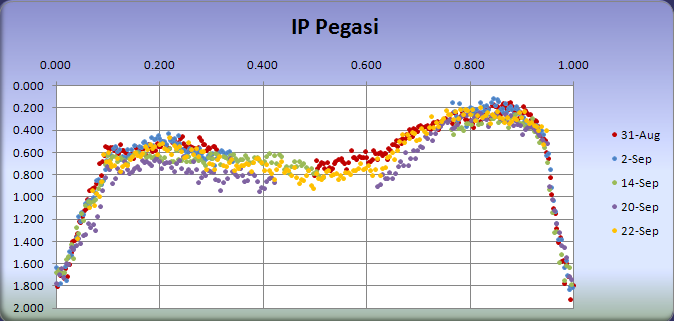 (March-October 2009) This is a graph of the light curve of the eclipsing binary star, IP Pegasi.
Photometry with the CCD camera shows the variable brightness (y-axis) plotted as a function of time
(x-axis). This unusual binary star has an orbital period of only 228 minutes, and as the
two stars revolve, matter falls from the companion star to the white dwarf primary star, creating a
hot-spot and forming an "accretion disc," similar to spiral arms of a galaxy, around the white dwarf.
The companion star also eclipses the white dwarf, creating the deep minimum in the light curve.
There are more eclipsing variables here.
(March-October 2009) This is a graph of the light curve of the eclipsing binary star, IP Pegasi.
Photometry with the CCD camera shows the variable brightness (y-axis) plotted as a function of time
(x-axis). This unusual binary star has an orbital period of only 228 minutes, and as the
two stars revolve, matter falls from the companion star to the white dwarf primary star, creating a
hot-spot and forming an "accretion disc," similar to spiral arms of a galaxy, around the white dwarf.
The companion star also eclipses the white dwarf, creating the deep minimum in the light curve.
There are more eclipsing variables here.
|
|
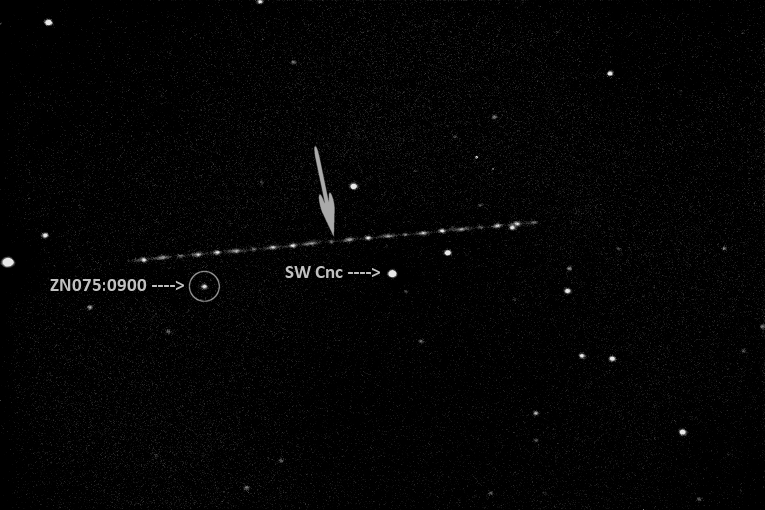 (23 March 2009) An unknown satellite tumbled through the field of view of this 50-second
exposure around SW Cancri, an eclipsing binary. Mid- exposure (arrow)
is at 01:08:38 UT, Mar 23. The 4-flash cycle in the image trail shows that, in the space
of 50 seconds, the satellite has tumbled about 5½ times.
At mid-exposure, the satellite's position is RA= 09:09:04.07 and Dec= +09:36:17.2,
and alt=57.092 and az=148.934. It's moving west to east (right to left) at a rate of 9.89 arcsec per sec.
The brightest flashes compare with the 15.1 magnitude star, ZN075:0900 (circled).
more
(23 March 2009) An unknown satellite tumbled through the field of view of this 50-second
exposure around SW Cancri, an eclipsing binary. Mid- exposure (arrow)
is at 01:08:38 UT, Mar 23. The 4-flash cycle in the image trail shows that, in the space
of 50 seconds, the satellite has tumbled about 5½ times.
At mid-exposure, the satellite's position is RA= 09:09:04.07 and Dec= +09:36:17.2,
and alt=57.092 and az=148.934. It's moving west to east (right to left) at a rate of 9.89 arcsec per sec.
The brightest flashes compare with the 15.1 magnitude star, ZN075:0900 (circled).
more
|
|
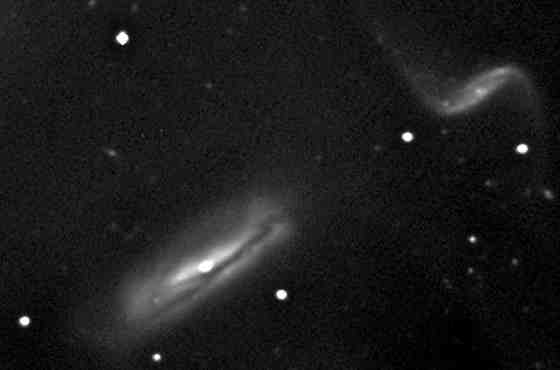 (17 January 2009) This is a 210-minute exposure in total, made up from 14 fifteen-minute
individual exposures taken under very poor conditions. NGC 3190 is a disturbed sprial galaxy about 60 million light years from
Earth, in the direction of the constellation of Leo. It and it's companion, NGC 3187, have had a
gravitational interaction over the eons, such that their spiral arms have been tidally distorted. These two
are members of a larger group, Hickson 44, comprising at least six galaxies in total. The
image scale in this image is 1.14 arcsec per pixel.
(17 January 2009) This is a 210-minute exposure in total, made up from 14 fifteen-minute
individual exposures taken under very poor conditions. NGC 3190 is a disturbed sprial galaxy about 60 million light years from
Earth, in the direction of the constellation of Leo. It and it's companion, NGC 3187, have had a
gravitational interaction over the eons, such that their spiral arms have been tidally distorted. These two
are members of a larger group, Hickson 44, comprising at least six galaxies in total. The
image scale in this image is 1.14 arcsec per pixel.
|
|
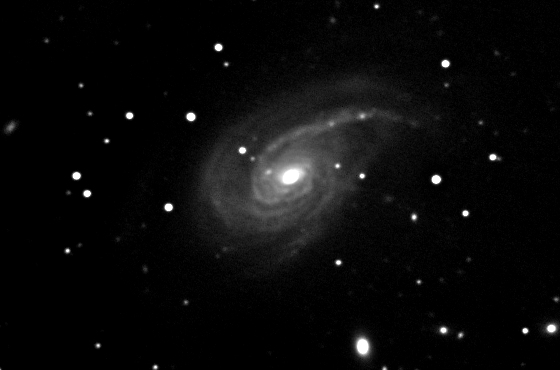 (1 November 2008) This 158-minute exposure of NGC 772 was composited from 19 500-second exposures.
The image scale in this image is 1.14 arcsec per pixel. NGC 772 is about twice the size of the Milky Way
Galaxy, located in the constellation of Aries at a distance of approximately 130 million light years.
This galaxy is also known as #78 in Arp's Atlas of Peculiar Galaxies. A smaller companion elliptical galaxy,
NGC 770 is seen to the southwest. In space, it's only a mere 160,000 light years from NGC 772.
(1 November 2008) This 158-minute exposure of NGC 772 was composited from 19 500-second exposures.
The image scale in this image is 1.14 arcsec per pixel. NGC 772 is about twice the size of the Milky Way
Galaxy, located in the constellation of Aries at a distance of approximately 130 million light years.
This galaxy is also known as #78 in Arp's Atlas of Peculiar Galaxies. A smaller companion elliptical galaxy,
NGC 770 is seen to the southwest. In space, it's only a mere 160,000 light years from NGC 772.
|
|
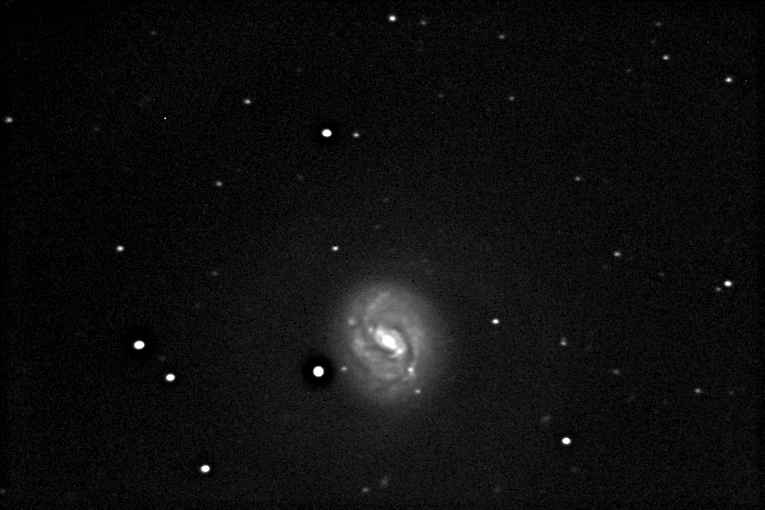 (23 October 2008) M 77 is a compact spiral galaxy located in the constellation Cetus the Whale.
Galaxies of the type of M77, with a small bright nucleus, are known as Seyfert galaxies.
Seyfert galaxies have very energetic cores and many similarities to quasars. There is also a strong source
of radio wave energy emitted from the core of this galaxy. M77, one of the brightest of the Seyfert galaxies, is
located at a distance of 60 million light years. It's spiral arms span 120,000 light years.
This image is a 145-minute exposure. The original image scale is 1.14 arcsec per pixel.
(23 October 2008) M 77 is a compact spiral galaxy located in the constellation Cetus the Whale.
Galaxies of the type of M77, with a small bright nucleus, are known as Seyfert galaxies.
Seyfert galaxies have very energetic cores and many similarities to quasars. There is also a strong source
of radio wave energy emitted from the core of this galaxy. M77, one of the brightest of the Seyfert galaxies, is
located at a distance of 60 million light years. It's spiral arms span 120,000 light years.
This image is a 145-minute exposure. The original image scale is 1.14 arcsec per pixel.
|
|
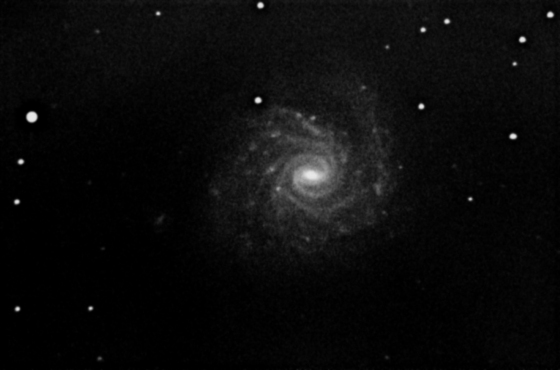 (20 October 2008) NGC 1232 is dominated by millions of bright stars and dark dust, in
spiral arms rotating about the center. Open clusters containing bright blue stars are
sprinkled along these spiral arms, with dark lanes of dense interstellar dust between.
The spiral arms are easily traced. This image is a 35 minute exposure. NGC 1232 is 70
million light years away, in the direction of the constellation Eridanus. The original image
scale is 1.14 arcsec per pixel.
(20 October 2008) NGC 1232 is dominated by millions of bright stars and dark dust, in
spiral arms rotating about the center. Open clusters containing bright blue stars are
sprinkled along these spiral arms, with dark lanes of dense interstellar dust between.
The spiral arms are easily traced. This image is a 35 minute exposure. NGC 1232 is 70
million light years away, in the direction of the constellation Eridanus. The original image
scale is 1.14 arcsec per pixel.
|
|
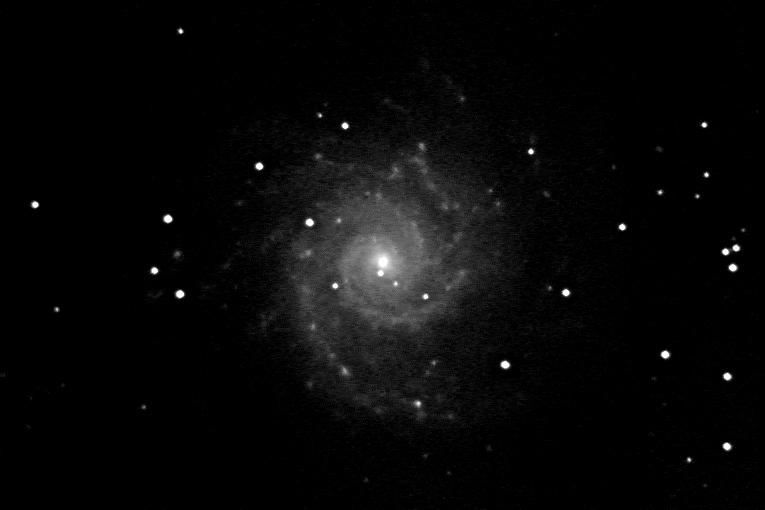 (20 October 2008) NGC 628, also known as M 74, is an island universe with 100 billion stars. It's located
30 million light years away in the direction of the constellation of Pisces. The spiral arms are easily
traced with clusters of bright young stars and gaseous nebulae. This image is a 25 minute exposure.
The original image scale is 1.14 arcsec per pixel.
(20 October 2008) NGC 628, also known as M 74, is an island universe with 100 billion stars. It's located
30 million light years away in the direction of the constellation of Pisces. The spiral arms are easily
traced with clusters of bright young stars and gaseous nebulae. This image is a 25 minute exposure.
The original image scale is 1.14 arcsec per pixel.
|
|
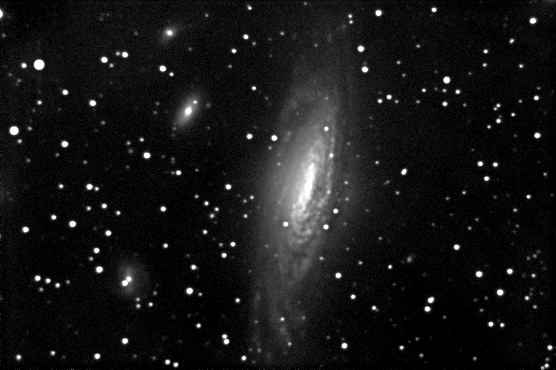 (04 August 2008) The brightest galaxy in Pegasus is this one: NGC7331 is a spiral at a distance
of 49 million lightyears. This photo is a composite of ten 10-minute exposures using an
SBIG ST7-XME CCD camera with a Schuler Clear filter. The images were registered, stacked,
contrast modified and sharpened in MaxIm v5. Three other, much more distant galaxies can be
seen in this photo. NGC 7337 is to the left and down, behind a star; NGC 7335 to the left and
up; and NGC 7325 to the right. The original image scale is 1.14 arcsec per pixel. Compare to an
August 2006 photo (Click here).
(04 August 2008) The brightest galaxy in Pegasus is this one: NGC7331 is a spiral at a distance
of 49 million lightyears. This photo is a composite of ten 10-minute exposures using an
SBIG ST7-XME CCD camera with a Schuler Clear filter. The images were registered, stacked,
contrast modified and sharpened in MaxIm v5. Three other, much more distant galaxies can be
seen in this photo. NGC 7337 is to the left and down, behind a star; NGC 7335 to the left and
up; and NGC 7325 to the right. The original image scale is 1.14 arcsec per pixel. Compare to an
August 2006 photo (Click here).
|
|
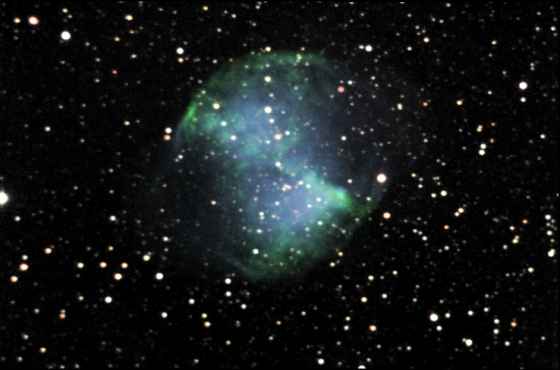 (17 July 2008) Messier 27 - the Dumbbell Nebula, is found in the constellation of Vulpecula, the fox. It is a planetary nebula. The
distance is not well known. A commonly quoted value is 1200 light years. Most of the light from this nebula is emitted in the green
part of the spectrum, at a wavelength of 5007 Angstroms. This image consists of 33 30-second images in each of three color bands,
V, R and I, plus 33 additional unfiltered images at 30 seconds each. The original image scale is 1.14 arcsec per pixel.
(17 July 2008) Messier 27 - the Dumbbell Nebula, is found in the constellation of Vulpecula, the fox. It is a planetary nebula. The
distance is not well known. A commonly quoted value is 1200 light years. Most of the light from this nebula is emitted in the green
part of the spectrum, at a wavelength of 5007 Angstroms. This image consists of 33 30-second images in each of three color bands,
V, R and I, plus 33 additional unfiltered images at 30 seconds each. The original image scale is 1.14 arcsec per pixel.
|
|
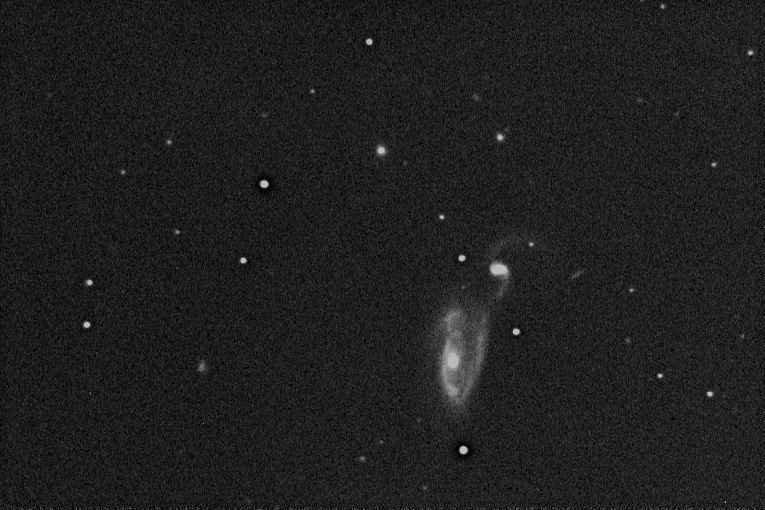 (29 May 2008) NGC 5395 (left) and NGC 5394, in Canes Venatici, are an interacting pair of spiral galaxies at a distance of roughly
184 million light years. The larger galaxy is about 155,000 light years across. Ten 2-minute exposures were stacked
and processed to improve contrast and detail. Another more distant galaxy, called PGC 211092, lies to the right of NGC 5394.
Computer simulations of galaxy encounters are able to reproduce some of the main features of this colliding system.
The original image scale is 1.14 arcsec per pixel.
(29 May 2008) NGC 5395 (left) and NGC 5394, in Canes Venatici, are an interacting pair of spiral galaxies at a distance of roughly
184 million light years. The larger galaxy is about 155,000 light years across. Ten 2-minute exposures were stacked
and processed to improve contrast and detail. Another more distant galaxy, called PGC 211092, lies to the right of NGC 5394.
Computer simulations of galaxy encounters are able to reproduce some of the main features of this colliding system.
The original image scale is 1.14 arcsec per pixel.
|
|
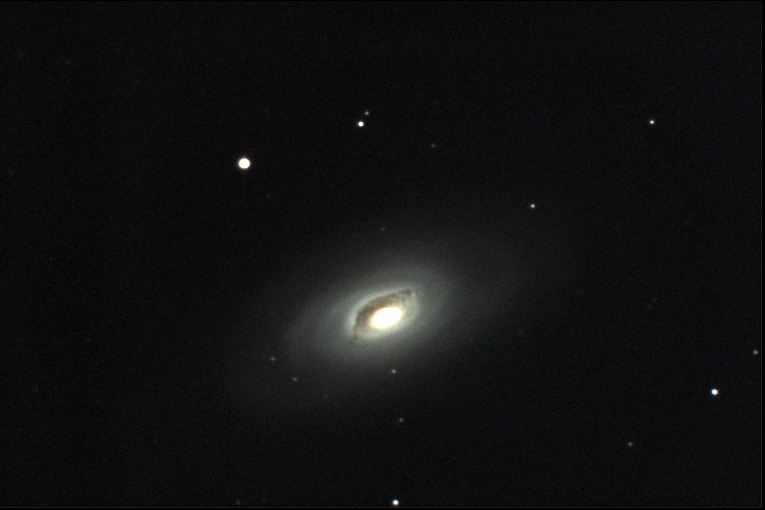 (05 May 2008) 19 million light years away, M64, sometimes called the "Blackeye Nebula", appears here
in a composite false-color image made from three 9-minute exposures, through I, R & V filters. These were
stacked and processed to improve contrast and detail. M64 is a barred spiral (type Sb) located in the constellation of
Coma Bernices and was first seen in 1779. M64 can be glimpsed in a good pair of binoculars. The conspicuous dark structure is a
dust feature that obscures the light from the stars behind it. The original image scale is 1.27 arcsec
per pixel. See also a 30 Apr 2006 image, below.
(05 May 2008) 19 million light years away, M64, sometimes called the "Blackeye Nebula", appears here
in a composite false-color image made from three 9-minute exposures, through I, R & V filters. These were
stacked and processed to improve contrast and detail. M64 is a barred spiral (type Sb) located in the constellation of
Coma Bernices and was first seen in 1779. M64 can be glimpsed in a good pair of binoculars. The conspicuous dark structure is a
dust feature that obscures the light from the stars behind it. The original image scale is 1.27 arcsec
per pixel. See also a 30 Apr 2006 image, below.
|
|
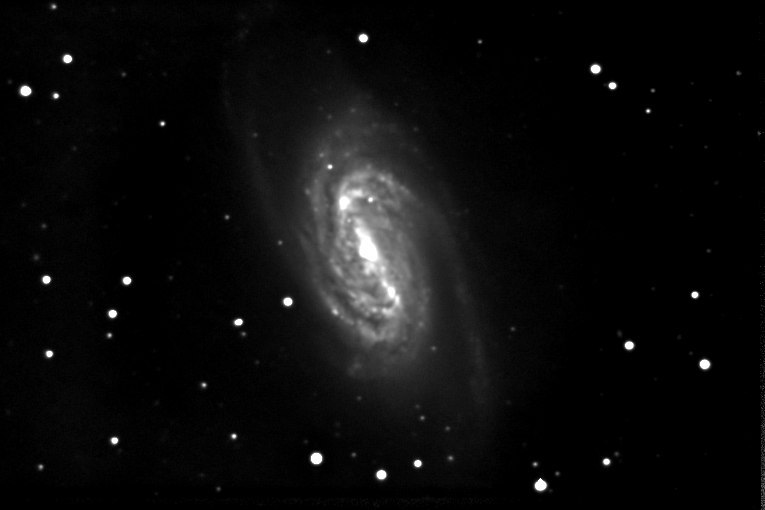 (03-10 Mar 2008) This new image of the barred-spiral galaxy, NGC 2903, is made from 57 individual 10-minute guided exposures
through a clear filter. These were stacked and processed to improve contrast and reveal the wispy outer arms of this galaxy.
NGC 2903 is a barred spiral (type Sb) located in the constellation of Leo, and is about 31 million
light-years away. The original image scale is 1.27 arcsec per pixel. I'm still working on it! (See also
21 Mar 2007 and 09 Feb 2006, below)
(03-10 Mar 2008) This new image of the barred-spiral galaxy, NGC 2903, is made from 57 individual 10-minute guided exposures
through a clear filter. These were stacked and processed to improve contrast and reveal the wispy outer arms of this galaxy.
NGC 2903 is a barred spiral (type Sb) located in the constellation of Leo, and is about 31 million
light-years away. The original image scale is 1.27 arcsec per pixel. I'm still working on it! (See also
21 Mar 2007 and 09 Feb 2006, below)
|
|
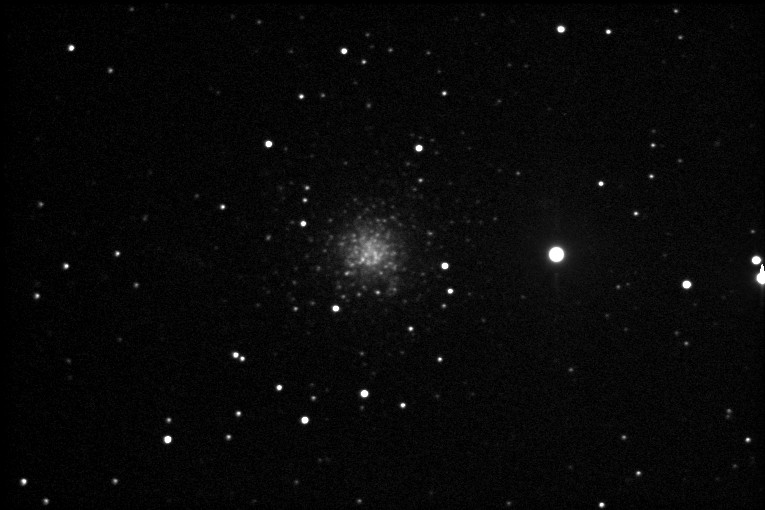 (30 Jan 2008) This is a ten-exposure composite photograph of the globular cluster called
the Intergalactic Wanderer,
totaling 5 minutes. Compare this with a similar picture of the same object from
10 Mar 2007.
The definition and contrast in the image is better here because of the dynamic digital processing
applied to the image. IGW is in the constellation of Lynx at a distance of 295,000 light-years, far
outside the boundaries of our Milky Way Galaxy. The original image scale is 1.27 arcsec per pixel.
Go back.
(30 Jan 2008) This is a ten-exposure composite photograph of the globular cluster called
the Intergalactic Wanderer,
totaling 5 minutes. Compare this with a similar picture of the same object from
10 Mar 2007.
The definition and contrast in the image is better here because of the dynamic digital processing
applied to the image. IGW is in the constellation of Lynx at a distance of 295,000 light-years, far
outside the boundaries of our Milky Way Galaxy. The original image scale is 1.27 arcsec per pixel.
Go back.
|
|
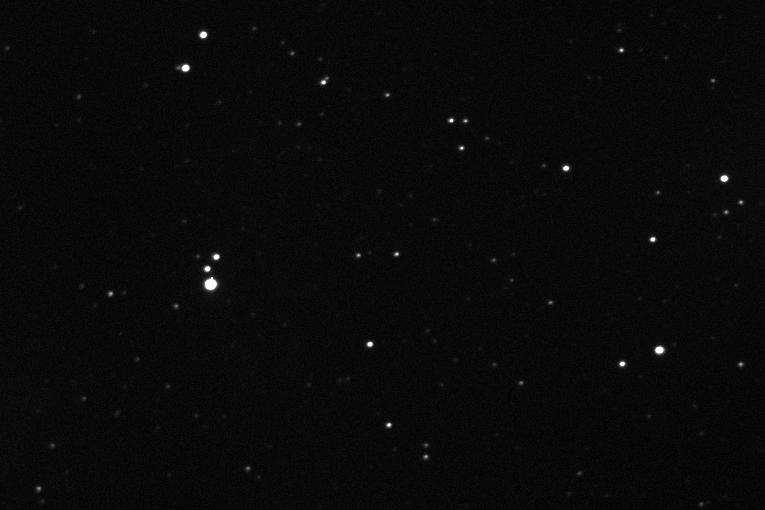 (21 Jan 2008) Here are two pictures of the asteroid 00169 Zelia. Each is a 30-second image - the first
is taken about 5 minutes before the second. It's retrograding, and in this pair it has moved only
about 2-1/2 pixels. According to Wikipedia, Zelia is a main-belt asteroid that was discovered by
the brothers Paul Henry and Prosper Henry on September 28, 1876. It is named after a niece of
the astronomer Camille Flammarion. Zelia has an orbital period of 3.62 years, a diameter of 34 km
and a rotation period of 13.3 hours. The original image scale is 1.27 arcsec per pixel.
(21 Jan 2008) Here are two pictures of the asteroid 00169 Zelia. Each is a 30-second image - the first
is taken about 5 minutes before the second. It's retrograding, and in this pair it has moved only
about 2-1/2 pixels. According to Wikipedia, Zelia is a main-belt asteroid that was discovered by
the brothers Paul Henry and Prosper Henry on September 28, 1876. It is named after a niece of
the astronomer Camille Flammarion. Zelia has an orbital period of 3.62 years, a diameter of 34 km
and a rotation period of 13.3 hours. The original image scale is 1.27 arcsec per pixel.
|
|
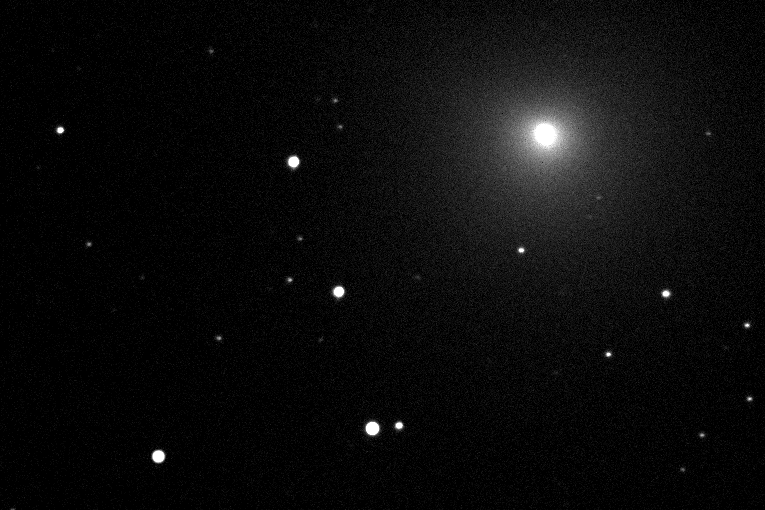 (03 Jan 2008) It's been a good year for comets. Here's a brief movie of Comet Tuttle/8P, a periodic comet that
returns every 13.6 years. This animation was made on a very windy night with bad seeing from 16 individual
sixty-second images taken over forty minutes. Near perihelion, it's speed through space right
now is a minimum of 80,000 miles per hour, in a highly eccentric orbit that carries it out
beyond the orbit of Saturn at its farthest point.
(03 Jan 2008) It's been a good year for comets. Here's a brief movie of Comet Tuttle/8P, a periodic comet that
returns every 13.6 years. This animation was made on a very windy night with bad seeing from 16 individual
sixty-second images taken over forty minutes. Near perihelion, it's speed through space right
now is a minimum of 80,000 miles per hour, in a highly eccentric orbit that carries it out
beyond the orbit of Saturn at its farthest point.
|
|
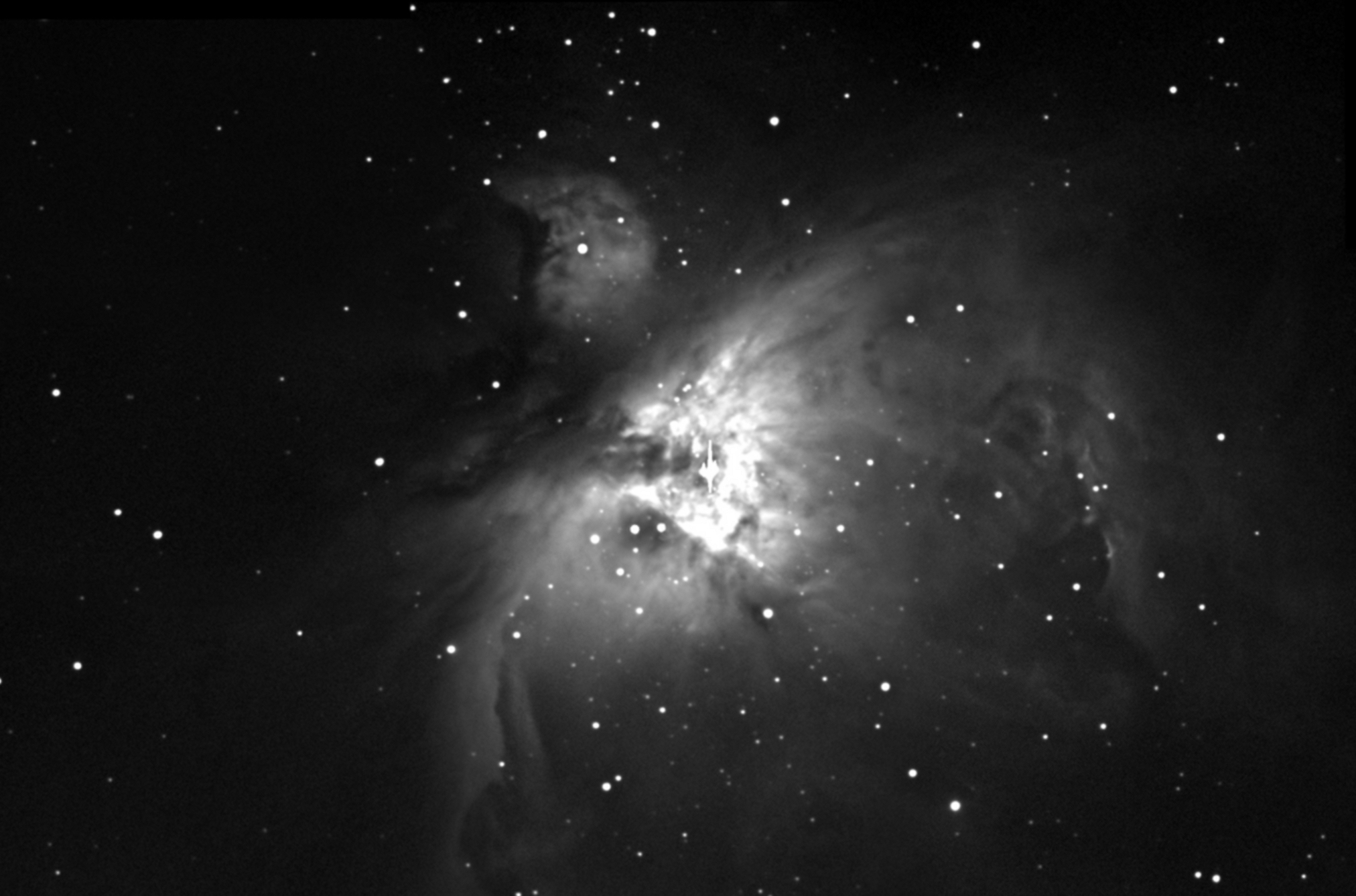 (17 Nov 2007) This is the same picture of the Orion Nebula complex as the one immediately below. The nine
images have been correctly calibrated and more carefully mosaicked using MaxIm. The seams between
the images have all but disappeared, and the contrast across the whole image has been adjusted to
bring out details in both the low-light regions and the bright regions.
(17 Nov 2007) This is the same picture of the Orion Nebula complex as the one immediately below. The nine
images have been correctly calibrated and more carefully mosaicked using MaxIm. The seams between
the images have all but disappeared, and the contrast across the whole image has been adjusted to
bring out details in both the low-light regions and the bright regions.
|
|
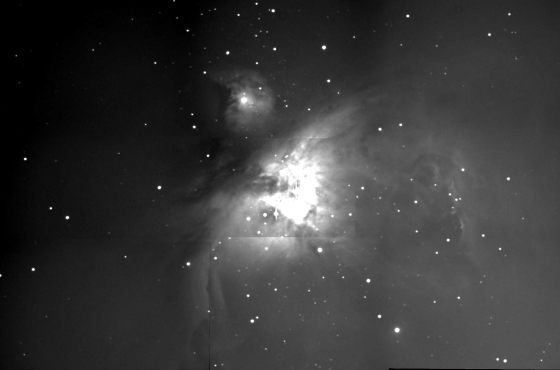 (17 Nov 2007) In this picture of the Orion Nebula complex, I've made a first attempt at making a
mosaic from individual images. Here there are nine images of 45 seconds each, and they were taken one after
the other. Balancing the grey tones was not too satisfactory because the images are not properly calibrated.
The whole field of view is 43' x 28', almost three times the size of an individual image. A picture
of the full moon would fit in this space. All images were taken at an original image scale of 1.27
arcsec per pixel.
(17 Nov 2007) In this picture of the Orion Nebula complex, I've made a first attempt at making a
mosaic from individual images. Here there are nine images of 45 seconds each, and they were taken one after
the other. Balancing the grey tones was not too satisfactory because the images are not properly calibrated.
The whole field of view is 43' x 28', almost three times the size of an individual image. A picture
of the full moon would fit in this space. All images were taken at an original image scale of 1.27
arcsec per pixel.
|
|
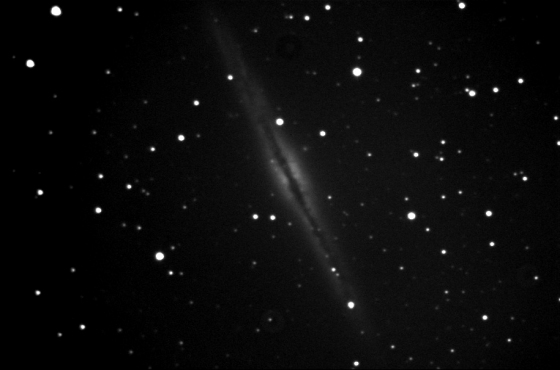 (17 Nov 2007) This picture of a magnificent edge-on spiral galaxy is a composite of 9 sixty-second
exposures, stacked and processed to bring out some of the fine detail. To do justice to this object
requires much longer exposure times. NGC 891 is at a distance of about 27 million light years, in
the direction of the constellation of Andromeda. The original image scale is 1.27 arcsec per pixel.
(see also 02 Sep 2007, below)
(17 Nov 2007) This picture of a magnificent edge-on spiral galaxy is a composite of 9 sixty-second
exposures, stacked and processed to bring out some of the fine detail. To do justice to this object
requires much longer exposure times. NGC 891 is at a distance of about 27 million light years, in
the direction of the constellation of Andromeda. The original image scale is 1.27 arcsec per pixel.
(see also 02 Sep 2007, below)
|
|
 (17 Nov 2007) This picture of Comet Holmes shows a more pronounce tail stretching from the comet's
head downward and slightly to the right. The image is a composite of several images totaling 170 seconds.
When this picture was taken Comet Holmes was almost 250 million kilometers from the Earth, and 380 million
kilometers from the Sun. Compare this image to the ones below, taken at the same image scale.
(17 Nov 2007) This picture of Comet Holmes shows a more pronounce tail stretching from the comet's
head downward and slightly to the right. The image is a composite of several images totaling 170 seconds.
When this picture was taken Comet Holmes was almost 250 million kilometers from the Earth, and 380 million
kilometers from the Sun. Compare this image to the ones below, taken at the same image scale.
|
|
.jpg) (29 Oct 2007) This picture of Comet Holmes is a mosaic of two images, showing how the comet has changed
its position in the sky relative to the background stars. The first (left) was taken at 03:35 UT 28 Oct.
The second (right) was taken at 05:13 UT 29 Oct. In the intervening 26 hours, as the comet was moving
away from the Sun, the coma expanded by about 25%. The image below shows the motion of the comet
in the space of 40 minutes on the 28th of October.
(29 Oct 2007) This picture of Comet Holmes is a mosaic of two images, showing how the comet has changed
its position in the sky relative to the background stars. The first (left) was taken at 03:35 UT 28 Oct.
The second (right) was taken at 05:13 UT 29 Oct. In the intervening 26 hours, as the comet was moving
away from the Sun, the coma expanded by about 25%. The image below shows the motion of the comet
in the space of 40 minutes on the 28th of October.
|
|
.gif) (28 Oct 2007) Here's an animation of Comet Holmes. Twenty exposures of 30 seconds duration each were stretched
using DDP, aligned and animated in MaxIm. The brightness variations are probably not real, because the background
and stars brightnesses were only crudely balanced. The twenty frames started at 03:30 UT represent about 40
minutes of elapsed time. The comet is at a distance of about 245 million kilometers from the Earth, which makes the halo
seen here about 350,000 km across. The original image scale is 1.27 arcsec per pixel.
(28 Oct 2007) Here's an animation of Comet Holmes. Twenty exposures of 30 seconds duration each were stretched
using DDP, aligned and animated in MaxIm. The brightness variations are probably not real, because the background
and stars brightnesses were only crudely balanced. The twenty frames started at 03:30 UT represent about 40
minutes of elapsed time. The comet is at a distance of about 245 million kilometers from the Earth, which makes the halo
seen here about 350,000 km across. The original image scale is 1.27 arcsec per pixel.
|
|
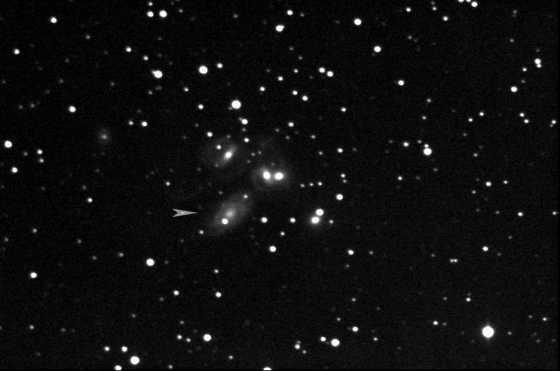 (06 Oct 2007) Stephan's Quintet is a visual grouping of five galaxies. The five of them, in an arc stretching
above the center of this image across to the left, are at a distance of 280 million light years and
are colliding or gravitationally interacting. Another (arrow; largest in the image) is 39 million light years away and only
appears superimposed near the more distant, interacting galaxies. This image was made from ten 10-minute exposures,
stacked, sharpened and contrast adjusted a bit. Stephan's Quintet is located in the constellation of
Pegasus. The original image scale is 1.27 arcsec per pixel.
(06 Oct 2007) Stephan's Quintet is a visual grouping of five galaxies. The five of them, in an arc stretching
above the center of this image across to the left, are at a distance of 280 million light years and
are colliding or gravitationally interacting. Another (arrow; largest in the image) is 39 million light years away and only
appears superimposed near the more distant, interacting galaxies. This image was made from ten 10-minute exposures,
stacked, sharpened and contrast adjusted a bit. Stephan's Quintet is located in the constellation of
Pegasus. The original image scale is 1.27 arcsec per pixel.
|
|
 (29 Sep 2007) IC 1340 is part of the larger diffuse nebula called the Veil Nebula. A remnant of
a 5-10 thousand-year-old supernova explosion, located in the direction of Cygnus at a distance of
2,600 light years, the Veil is six times the diameter of the full Moon. IC 1340 is a very small
part of the whole Veil. Forty-seven 1-minute exposure were aligned and stacked, then sharpened and
contrast stretched with DDP. The original image scale is 1.27 arcsec per pixel.
(29 Sep 2007) IC 1340 is part of the larger diffuse nebula called the Veil Nebula. A remnant of
a 5-10 thousand-year-old supernova explosion, located in the direction of Cygnus at a distance of
2,600 light years, the Veil is six times the diameter of the full Moon. IC 1340 is a very small
part of the whole Veil. Forty-seven 1-minute exposure were aligned and stacked, then sharpened and
contrast stretched with DDP. The original image scale is 1.27 arcsec per pixel.
|
|
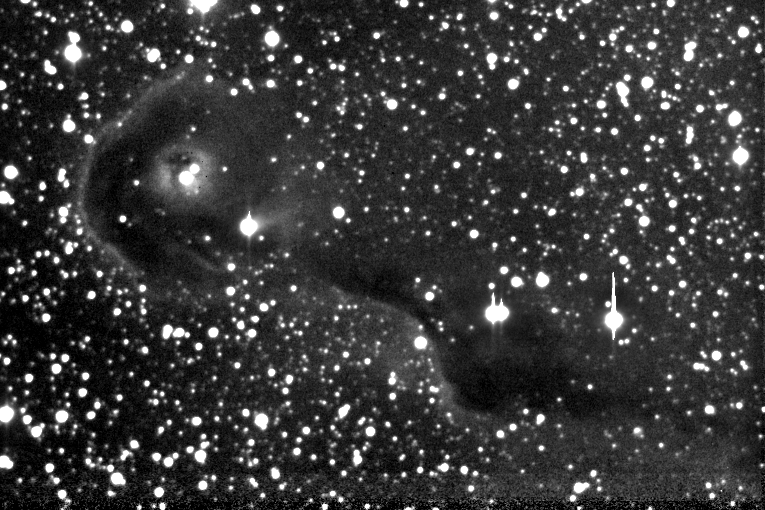 (18 Sep 2007) This stellar nursery, in the constellation of Cepheus, is located just over 2700 light-years
from Earth. Called the "Elephant Trunk Nebula," the whole region, of which this is less than a hundreth part, spans an area
in the sky six times the size of the moon. The "trunk" seen here is about 10 light-years long. The area includes hot,
ionized hydrogen regions (bright curved edges) behind dark lanes of denser hydrogen gas, and reflection nebulae near
the brightest stars. 164 unfiltered images were processed and stacked, for a total exposure of 2h 16m. The original
image scale is 1.27 arcsec per pixel.
(18 Sep 2007) This stellar nursery, in the constellation of Cepheus, is located just over 2700 light-years
from Earth. Called the "Elephant Trunk Nebula," the whole region, of which this is less than a hundreth part, spans an area
in the sky six times the size of the moon. The "trunk" seen here is about 10 light-years long. The area includes hot,
ionized hydrogen regions (bright curved edges) behind dark lanes of denser hydrogen gas, and reflection nebulae near
the brightest stars. 164 unfiltered images were processed and stacked, for a total exposure of 2h 16m. The original
image scale is 1.27 arcsec per pixel.
|
|
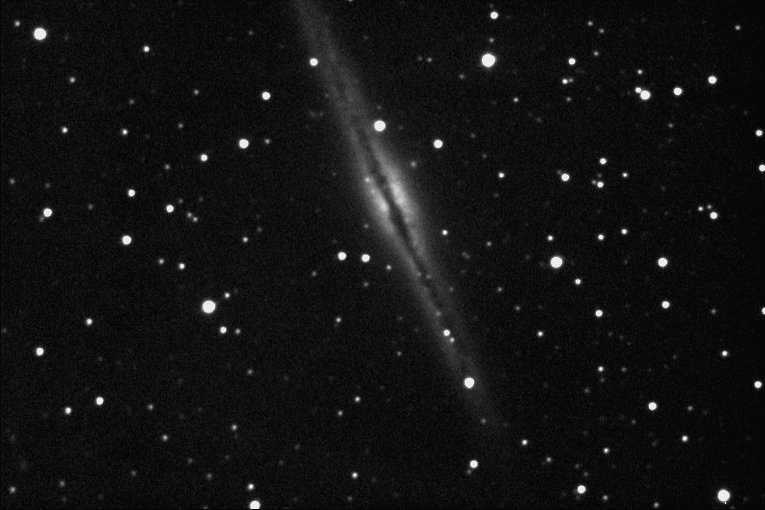 (02 Sep 2007) This fine spiral galaxy is seen edge-on in a 45 minute unfiltered exposure made from 30 90-second
individual unfiltered frames, stacked and digitally processed. NGC 891, located in the constellation of Andromeda, is a typical
spiral galaxy having bright stars, gas and obscuring dust in a thin disk. Seen edge-on, the dark band through the middle is
a zone of dust absorbing the light from the integrated starlight behind it. The distance is estimated to be just over 27 million light years from us.
The original image scale is 1.27 arcsec per pixel.
(02 Sep 2007) This fine spiral galaxy is seen edge-on in a 45 minute unfiltered exposure made from 30 90-second
individual unfiltered frames, stacked and digitally processed. NGC 891, located in the constellation of Andromeda, is a typical
spiral galaxy having bright stars, gas and obscuring dust in a thin disk. Seen edge-on, the dark band through the middle is
a zone of dust absorbing the light from the integrated starlight behind it. The distance is estimated to be just over 27 million light years from us.
The original image scale is 1.27 arcsec per pixel.
|
|
 (28 Aug 2007) Here is a b/w image of Messier 16 - the Eagle Nebula. The image is the result of stacking 20 two-minute
exposures taken through a 9 nm H-alpha filter. M 16 is a great cloud of interstellar gas at a distance of 7,000 light
years toward the constellation of Serpens. The massive, hot young stars in the cluster formed out of this cloud not much more
than 5-1/2 million years ago. The original image scale is 1.27 arcsec per pixel. Compare this with a similar picture taken
through an R filter a year ago (below).
(28 Aug 2007) Here is a b/w image of Messier 16 - the Eagle Nebula. The image is the result of stacking 20 two-minute
exposures taken through a 9 nm H-alpha filter. M 16 is a great cloud of interstellar gas at a distance of 7,000 light
years toward the constellation of Serpens. The massive, hot young stars in the cluster formed out of this cloud not much more
than 5-1/2 million years ago. The original image scale is 1.27 arcsec per pixel. Compare this with a similar picture taken
through an R filter a year ago (below).
|
|
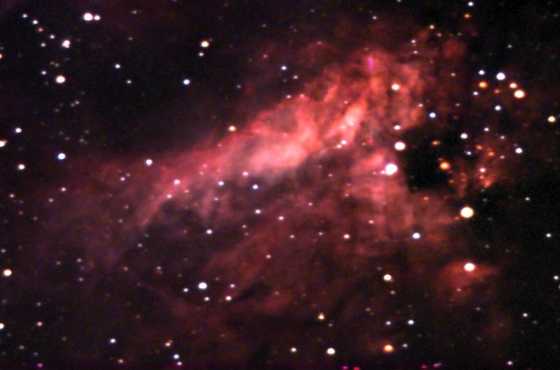 (12 Aug 2007) This image of Messier 17 is made from thirty 30-second unfiltered exposures, aligned and stacked, along with
R, V and B images of 450 seconds each. Located in the constellation of Sagittarius, M-17 (the Omega Nebula) is at
a distance of about 5,000 light-years.
(12 Aug 2007) This image of Messier 17 is made from thirty 30-second unfiltered exposures, aligned and stacked, along with
R, V and B images of 450 seconds each. Located in the constellation of Sagittarius, M-17 (the Omega Nebula) is at
a distance of about 5,000 light-years.
|
|
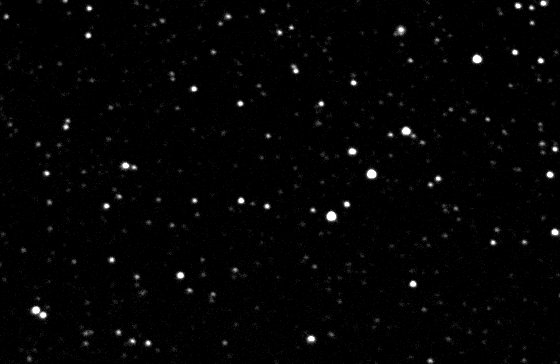 (1 Aug 2007) Here are two sixty-second exposures of Pluto taken 38 minutes apart, merged into one animation.
At 14th magnitude, Pluto moved 1.5 arcsecond to the west in the time between the exposures.
At the distance of Pluto (5,800 million km.), this amounts to over 11,000 km. The next image below is another animation
showing Pluto's movement of 4,000,000+ kilometers over a period of eleven days.
(1 Aug 2007) Here are two sixty-second exposures of Pluto taken 38 minutes apart, merged into one animation.
At 14th magnitude, Pluto moved 1.5 arcsecond to the west in the time between the exposures.
At the distance of Pluto (5,800 million km.), this amounts to over 11,000 km. The next image below is another animation
showing Pluto's movement of 4,000,000+ kilometers over a period of eleven days.
|
|
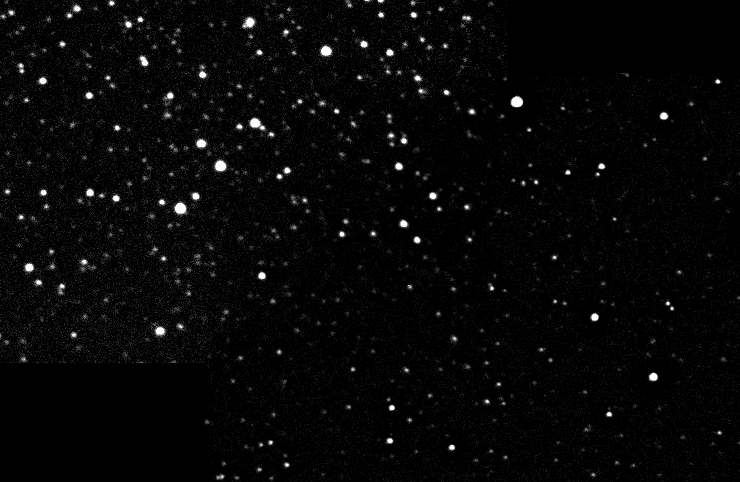 (12 Aug 2007) This animation is of two pairs of images of Pluto taken eleven days apart, the first pair on August 1 (UT),
the other on August 12 (UT).
All images were sixty second unfiltered exposures. Because of the mosaicking process, Pluto appears fainter in the later exposure (right),
although is has actually not dimmed appreciably in the intervening time. Pluto moved from RA 17h 45m 40s, Dec -16d 29m 39s on
August 1st to RA 17h 44m 57s, Dec -16d 32m 22s on August 12th. The earlier exposure (same as above) is on the left.
Can you see where Pluto moved to?
(12 Aug 2007) This animation is of two pairs of images of Pluto taken eleven days apart, the first pair on August 1 (UT),
the other on August 12 (UT).
All images were sixty second unfiltered exposures. Because of the mosaicking process, Pluto appears fainter in the later exposure (right),
although is has actually not dimmed appreciably in the intervening time. Pluto moved from RA 17h 45m 40s, Dec -16d 29m 39s on
August 1st to RA 17h 44m 57s, Dec -16d 32m 22s on August 12th. The earlier exposure (same as above) is on the left.
Can you see where Pluto moved to?
|
|
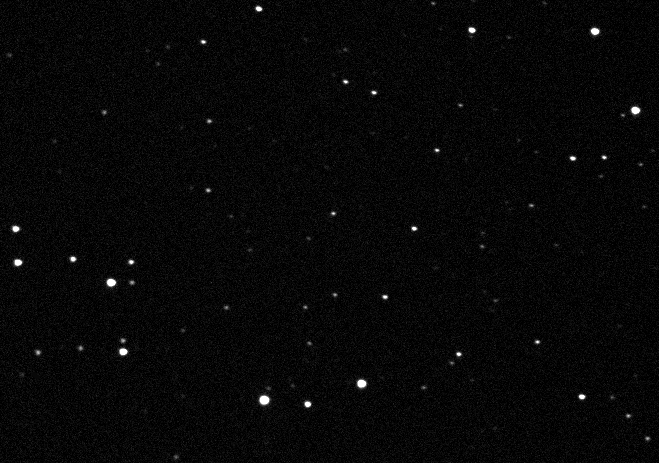 (10 Jun 2007) This animation (6 MB .gif) shows the variable star DQ Herculis, in the very center of the frame, in action.
There are 100 exposures of
60 seconds each in this series, taken over a period of 2h 57m. During the deep eclipse in the middle
of the sequence, DQ Her briefly disappears (fainter than 17th magnitude). In addition to being an eclipsing binary system
with a period of 4h 37m, DQ Her is also a cataclysmic variable with much shorter, rapid variability (not
seen in this movie). The observations here cover about two-thirds of the eclipse cycle.
(10 Jun 2007) This animation (6 MB .gif) shows the variable star DQ Herculis, in the very center of the frame, in action.
There are 100 exposures of
60 seconds each in this series, taken over a period of 2h 57m. During the deep eclipse in the middle
of the sequence, DQ Her briefly disappears (fainter than 17th magnitude). In addition to being an eclipsing binary system
with a period of 4h 37m, DQ Her is also a cataclysmic variable with much shorter, rapid variability (not
seen in this movie). The observations here cover about two-thirds of the eclipse cycle.
|
|
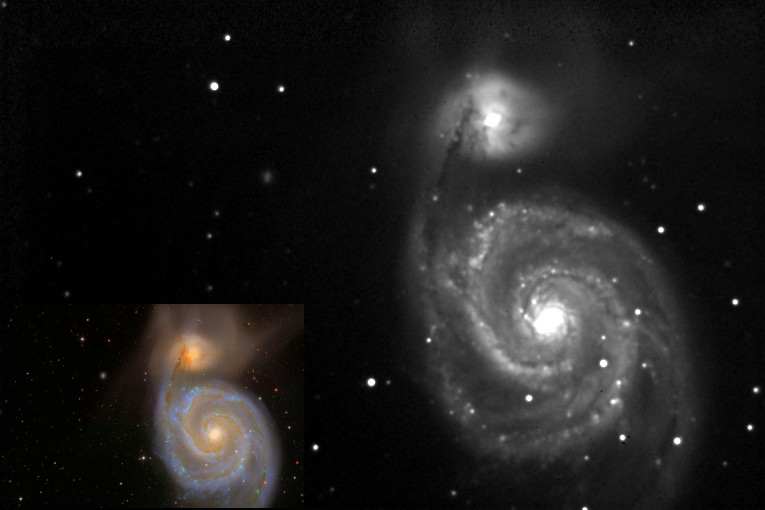 (25 May 2007) Fifteen unfiltered, guided exposures of nine minutes each were stacked using MaxIm to produce this image.
M-51 is off-centered to permit offset guiding on a particular field star. The image was further
processed using digital development, and the brightness was adjusted to reveal the wispy gas surrounding this galaxy. The
far distant irregular galaxy IC 4278 is left of center, below the triangle of nearby stars. The original scale is 1.27 arcsec per pixel.
Compare this with the inset from the Sloan Digital Sky Survey.
(25 May 2007) Fifteen unfiltered, guided exposures of nine minutes each were stacked using MaxIm to produce this image.
M-51 is off-centered to permit offset guiding on a particular field star. The image was further
processed using digital development, and the brightness was adjusted to reveal the wispy gas surrounding this galaxy. The
far distant irregular galaxy IC 4278 is left of center, below the triangle of nearby stars. The original scale is 1.27 arcsec per pixel.
Compare this with the inset from the Sloan Digital Sky Survey.
|
|
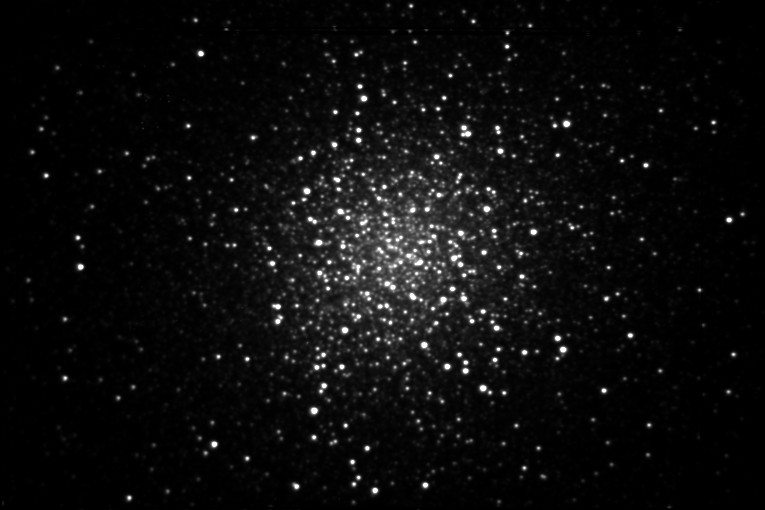 (09 May 2007) Having created a decent animation of the RR Lyrae stars in M3, I went after them in M13.
I took 204 60-second unfiltered exposures in a row,
with an occasional refocus. When I looked at the images sequentially with MaxIm's animation tool, I didn't see anything varying (!?!).
So, instead, I aligned and stacked the images, creating a single image equivalent to 3h 24m exposure. The seeing was remarkably constant throughout.
The stack was processed with the DDP tool. The original scale is 1.27 arcsec/pixel. Compare this with a year
earlier image of M13 below (25 April 2006).
(09 May 2007) Having created a decent animation of the RR Lyrae stars in M3, I went after them in M13.
I took 204 60-second unfiltered exposures in a row,
with an occasional refocus. When I looked at the images sequentially with MaxIm's animation tool, I didn't see anything varying (!?!).
So, instead, I aligned and stacked the images, creating a single image equivalent to 3h 24m exposure. The seeing was remarkably constant throughout.
The stack was processed with the DDP tool. The original scale is 1.27 arcsec/pixel. Compare this with a year
earlier image of M13 below (25 April 2006).
|
|
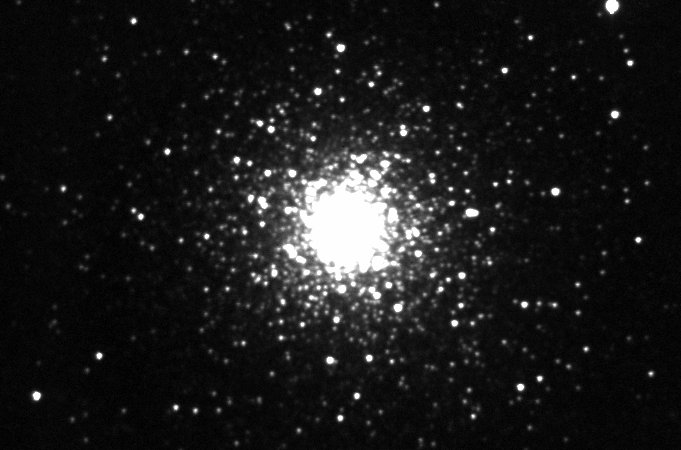 (22 Apr 2007) I was inspired by a recent APOD (15 April)
to make this movie of M3. There are 45 200-second unfiltered exposures in a row,
with an occasional refocus. Three consecutive images are combined to make 15 frames in all. The
movie plays for 3 seconds and covers just over 3 hours of real time.
If you study this as it runs, you can see many RR Lyrae variable stars brightening and dimming. It's not
atmospheric scintillation!
At 1.27 arcsec/pixel, better would be a larger scale of 1.0 or 0.7
arcsec/pixel. M3 is 33,900 light years distant and contains ~500,000 stars. Go back.
(22 Apr 2007) I was inspired by a recent APOD (15 April)
to make this movie of M3. There are 45 200-second unfiltered exposures in a row,
with an occasional refocus. Three consecutive images are combined to make 15 frames in all. The
movie plays for 3 seconds and covers just over 3 hours of real time.
If you study this as it runs, you can see many RR Lyrae variable stars brightening and dimming. It's not
atmospheric scintillation!
At 1.27 arcsec/pixel, better would be a larger scale of 1.0 or 0.7
arcsec/pixel. M3 is 33,900 light years distant and contains ~500,000 stars. Go back.
|
|
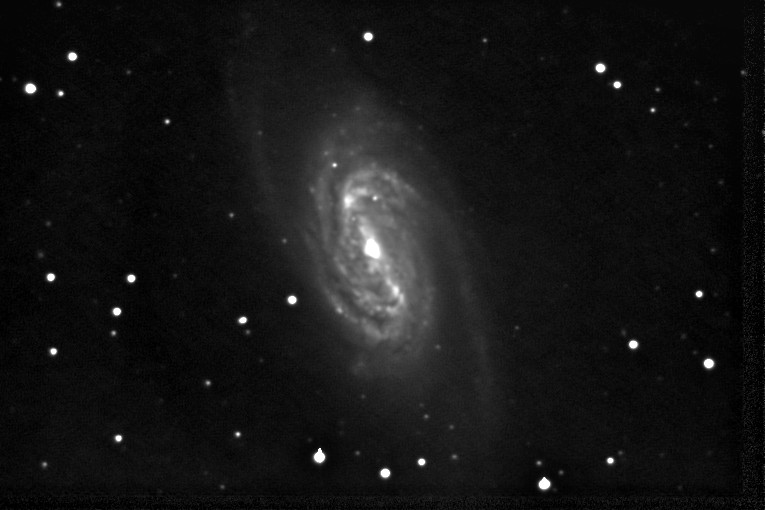 (21 Mar 2007) This new picture of NGC 2903 was made by combining five 7-1/2 minute
images through a clear filter. NGC 2903 is a barred spiral (type Sb) located in
the constellation of Leo, and is about 31 million light-years away. The original
scale of the image is 1.27 arcsec per pixel. The images were reprocessed in August 2009.
Compare this picture with the one below, taken a year ago on 09 Feb 2006.
Go back.
(21 Mar 2007) This new picture of NGC 2903 was made by combining five 7-1/2 minute
images through a clear filter. NGC 2903 is a barred spiral (type Sb) located in
the constellation of Leo, and is about 31 million light-years away. The original
scale of the image is 1.27 arcsec per pixel. The images were reprocessed in August 2009.
Compare this picture with the one below, taken a year ago on 09 Feb 2006.
Go back.
|
|
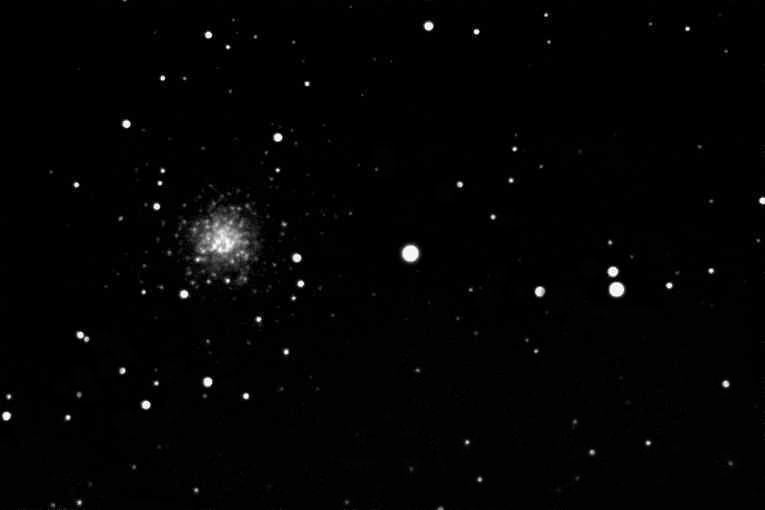 (10 Mar 2007) At a distance of 295,000 light-years, the Intergalactic Wanderer, NGC 2419, is the most remote
object in the Milky Way Galaxy visible to moderate-sized telescopes. Some suggest that this is a globular cluster
barely in orbit around the Milky Way - hence its name. Most globular clusters in the MWG are about 10
times closer. This image is a ten-minute unfiltered exposure. The stars in this image are nearby and part of the
constellation Lynx. The original scale of the image is 1.27 arcsec per pixel. Go back.
(10 Mar 2007) At a distance of 295,000 light-years, the Intergalactic Wanderer, NGC 2419, is the most remote
object in the Milky Way Galaxy visible to moderate-sized telescopes. Some suggest that this is a globular cluster
barely in orbit around the Milky Way - hence its name. Most globular clusters in the MWG are about 10
times closer. This image is a ten-minute unfiltered exposure. The stars in this image are nearby and part of the
constellation Lynx. The original scale of the image is 1.27 arcsec per pixel. Go back.
|
|
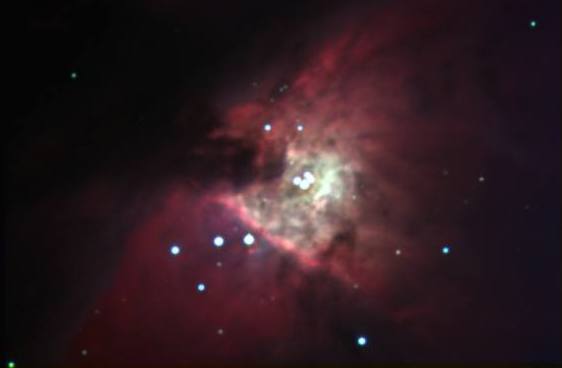 (05 Feb 2007) This was an experimental photograph of M 42 taken with an H-alpha filter (15x30 second exposures),
and V and B filters (5x7 second exposure each), and composited into a false color image. Compare with the image of M 42
taken on 24 November (below). The colors here are a little subtler. The original scale of the image is 1.27 arcsec per
pixel.
(05 Feb 2007) This was an experimental photograph of M 42 taken with an H-alpha filter (15x30 second exposures),
and V and B filters (5x7 second exposure each), and composited into a false color image. Compare with the image of M 42
taken on 24 November (below). The colors here are a little subtler. The original scale of the image is 1.27 arcsec per
pixel.
|
|
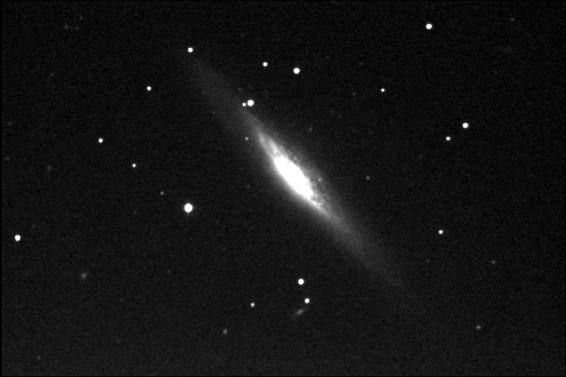 (11 Jan 2007) The spiral galaxy, NGC 2683, is much like our own Milky Way and seen nearly edge-on. It's at a distance of
16 million light-years in the direction of the constellation Lynx. Six ten-minute autoguided exposures taken through an R filter
were combined to produce this image. Another far distant galaxy is seen in the background. See another picture of NGC 2683
taken on 28 Jan 2005, below.
(11 Jan 2007) The spiral galaxy, NGC 2683, is much like our own Milky Way and seen nearly edge-on. It's at a distance of
16 million light-years in the direction of the constellation Lynx. Six ten-minute autoguided exposures taken through an R filter
were combined to produce this image. Another far distant galaxy is seen in the background. See another picture of NGC 2683
taken on 28 Jan 2005, below.
|
|
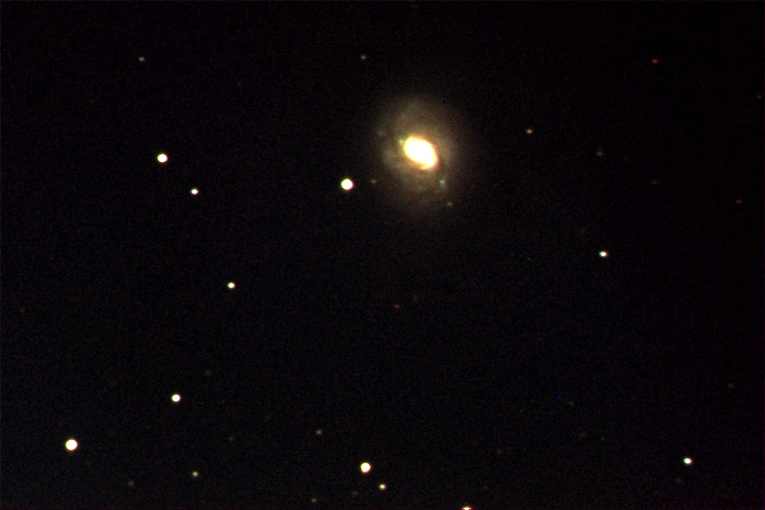 (03 Jan 2007) This false color photograph of M 77, also known as the bright radio source Cetus-A, was made by aligning
and stacking two 7-1/2-minute autoguided exposures taken through each of three filters: I, R, and V (6 photos total; 45 minutes exposure total). The image scale is 1.1 arcsec per
pixel. Cetus-A is at a distance of 60 million light years; 120,000 light years in diameter; moving away from us at 1100 kilometer
per second; and by some estimates contains 1 trillion stars. In 1952, the core of this galaxy was found to be a strong source of
radio emission.
(03 Jan 2007) This false color photograph of M 77, also known as the bright radio source Cetus-A, was made by aligning
and stacking two 7-1/2-minute autoguided exposures taken through each of three filters: I, R, and V (6 photos total; 45 minutes exposure total). The image scale is 1.1 arcsec per
pixel. Cetus-A is at a distance of 60 million light years; 120,000 light years in diameter; moving away from us at 1100 kilometer
per second; and by some estimates contains 1 trillion stars. In 1952, the core of this galaxy was found to be a strong source of
radio emission.
|
|
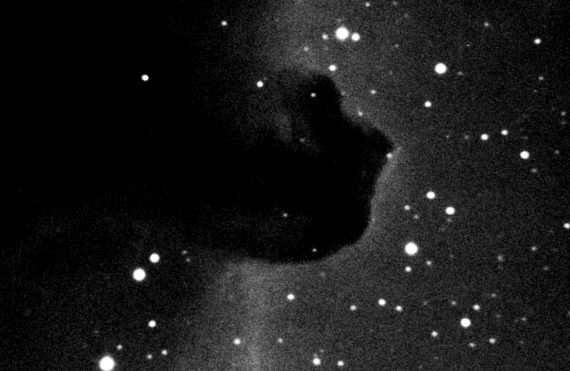 (24 Dec 2006) No. 33 in the Barnard Catalog (B 33), the Horsehead Nebula is at a distance of 1600 light-years, and is seen here in a 32-minutes exposure through an R filter. B33 is a dark globule of dust and non-luminous gas, obscuring the light coming from behind (IC 434). The image is a composite of the sharpest of 60 one-minute exposures, aligned and stacked, and contrast adjusted. One of the exposures by itself barely reveals the outline of the horse's head. The original plate scale is 1.1 arcsec per pixel.
(24 Dec 2006) No. 33 in the Barnard Catalog (B 33), the Horsehead Nebula is at a distance of 1600 light-years, and is seen here in a 32-minutes exposure through an R filter. B33 is a dark globule of dust and non-luminous gas, obscuring the light coming from behind (IC 434). The image is a composite of the sharpest of 60 one-minute exposures, aligned and stacked, and contrast adjusted. One of the exposures by itself barely reveals the outline of the horse's head. The original plate scale is 1.1 arcsec per pixel.
|
|
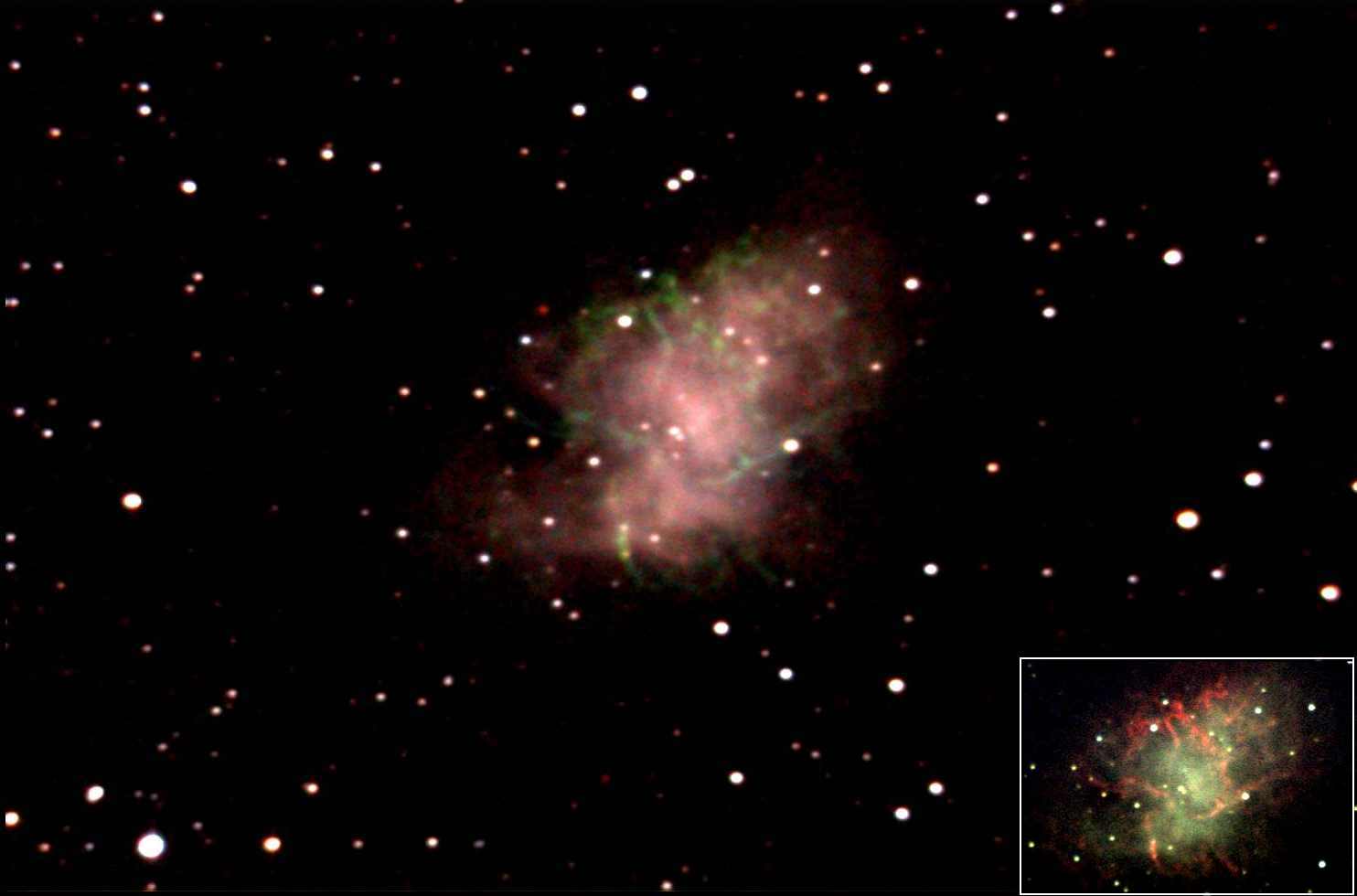 (17 Dec 2006) This false-color photograph of the Crab Nebula was made by compositing a seven-minute exposure through
a clear filter with three four minute exposures at lower resolution through I, R and V filters.
The individual 30-second images were registered and stacked using MaxIm. Then the composites were color-merged using MaxIm's
"LRGB-combine" process, with I, R and V images in place of R, G and B images. The original scale is 1.1 arcsec per pixel. Compare with
the inset photo from 22 Feb 2006.
(17 Dec 2006) This false-color photograph of the Crab Nebula was made by compositing a seven-minute exposure through
a clear filter with three four minute exposures at lower resolution through I, R and V filters.
The individual 30-second images were registered and stacked using MaxIm. Then the composites were color-merged using MaxIm's
"LRGB-combine" process, with I, R and V images in place of R, G and B images. The original scale is 1.1 arcsec per pixel. Compare with
the inset photo from 22 Feb 2006.
|
|
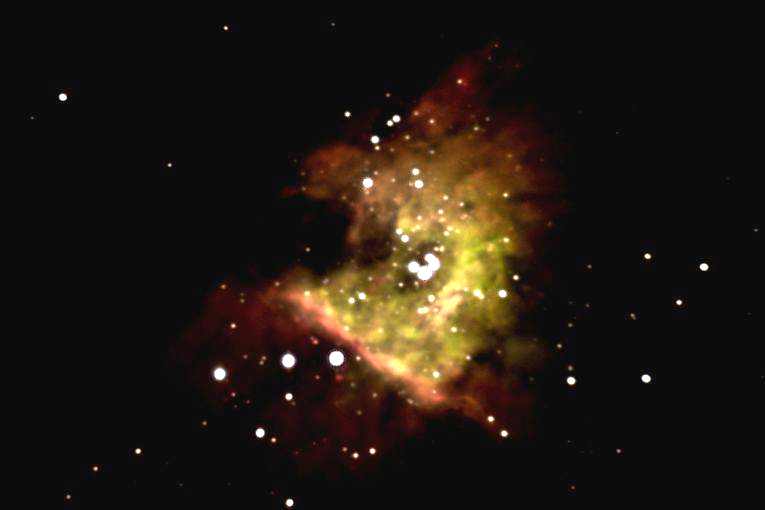 (24 Nov 2006) The M42 exposures and times through each filter varied in order to minimize blooming:
25xI at 25 sec, 70xR at 7 sec, 70xV at 7 sec, and 35xB at 15 sec. The composite images, made from
the sharpest twelve exposures of each of the I, R, V and B images
were registered and stacked using MaxIm. Then the composites were color-merged using MaxIm's
"LRGB-combine" process, with the "I" image standing in as the "L". Note how much sharper
the stars are in this image compared to the image immediately below. The original scale is 1.1 arcsec per pixel.
(24 Nov 2006) The M42 exposures and times through each filter varied in order to minimize blooming:
25xI at 25 sec, 70xR at 7 sec, 70xV at 7 sec, and 35xB at 15 sec. The composite images, made from
the sharpest twelve exposures of each of the I, R, V and B images
were registered and stacked using MaxIm. Then the composites were color-merged using MaxIm's
"LRGB-combine" process, with the "I" image standing in as the "L". Note how much sharper
the stars are in this image compared to the image immediately below. The original scale is 1.1 arcsec per pixel.
|
|
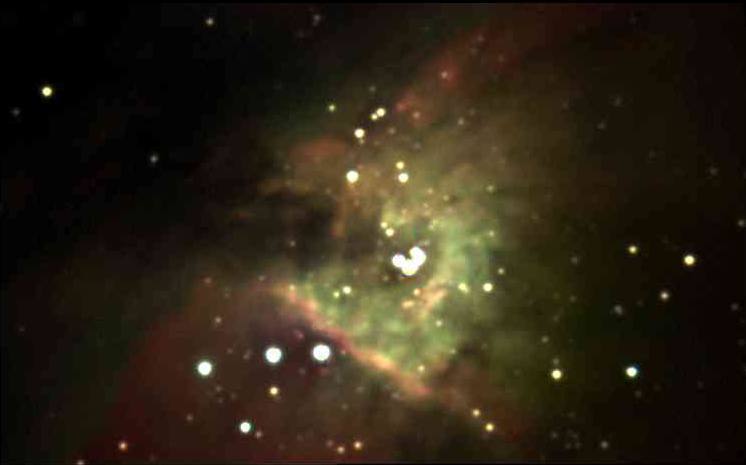 (10 Nov 2006) A late-night image of the Orion Nebula (M-42). This composite image was made from
five 30-second exposure through each of the I, R, V and B filters. The five images through each filter
were registered and stacked using MaxIm. Then the composite IRVB images were color-merged using MaxIm's
"LRGB-combine" process. The color mix is not physics-based. The fine detail of stars comes from the "I" image. Compare this with the earlier images
of M 42 shown below. The original image scale is 1.1 arcsec per pixel.
(10 Nov 2006) A late-night image of the Orion Nebula (M-42). This composite image was made from
five 30-second exposure through each of the I, R, V and B filters. The five images through each filter
were registered and stacked using MaxIm. Then the composite IRVB images were color-merged using MaxIm's
"LRGB-combine" process. The color mix is not physics-based. The fine detail of stars comes from the "I" image. Compare this with the earlier images
of M 42 shown below. The original image scale is 1.1 arcsec per pixel.
|
|
.jpg) (18 Aug 2006) The brightest galaxy in Pegasus is this one - NGC7331. It's a spiral at a distance
of 49 million lightyears. This photo is a composite of seven 1-minute exposures using the
SBIG ST7-XME with a Schuler R filter. The images were registered, stacked, contrast modified and
sharpened. Three other, much more distant galaxies can be seen in this photo, marked with
circles: NGC 7337 to the left and down, behind a star; NGC 7335 to the left and up; and NGC 7325 to the right.
The spiral appears oval because we see it at an oblique angle. The original image scale is 1.1
arcsec per pixel. Go back.
(18 Aug 2006) The brightest galaxy in Pegasus is this one - NGC7331. It's a spiral at a distance
of 49 million lightyears. This photo is a composite of seven 1-minute exposures using the
SBIG ST7-XME with a Schuler R filter. The images were registered, stacked, contrast modified and
sharpened. Three other, much more distant galaxies can be seen in this photo, marked with
circles: NGC 7337 to the left and down, behind a star; NGC 7335 to the left and up; and NGC 7325 to the right.
The spiral appears oval because we see it at an oblique angle. The original image scale is 1.1
arcsec per pixel. Go back.
|
|
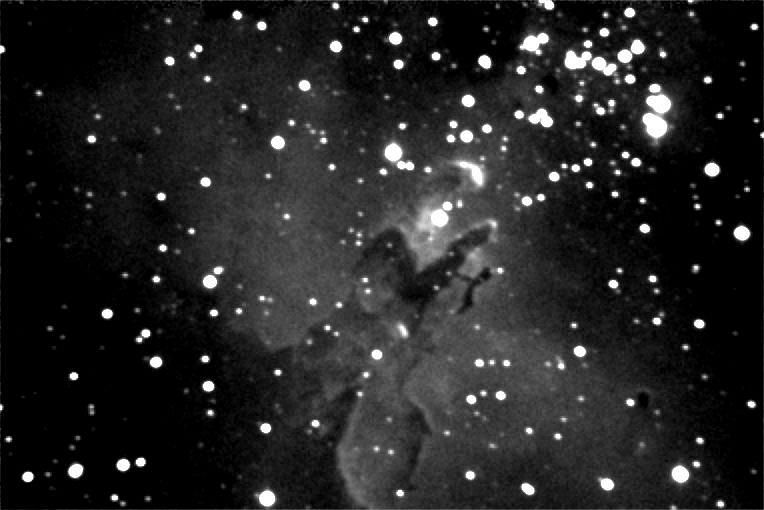 (8 Aug 2006) Eight 60-second images of M16/IC 4703 through a red filter, binning 2, were taken on a hazy night,
with the gibbous moon about 30 degrees away in the sky. The images were stacked and contrast stretched, and the new
image was double-sized in MaxIm, then sharpened a bit. The original image scale is 2.2
arcsec per pixel.
(8 Aug 2006) Eight 60-second images of M16/IC 4703 through a red filter, binning 2, were taken on a hazy night,
with the gibbous moon about 30 degrees away in the sky. The images were stacked and contrast stretched, and the new
image was double-sized in MaxIm, then sharpened a bit. The original image scale is 2.2
arcsec per pixel.
|
|
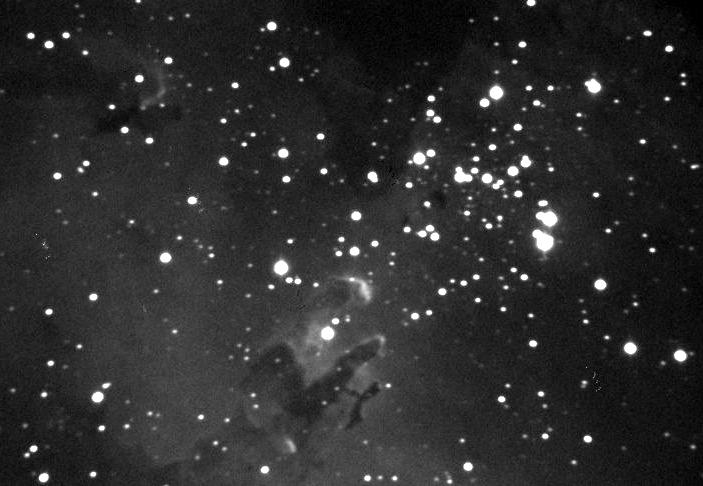 (18 Jul 2006) Eleven 60-second images of M16/IC 4703 through a red filter were stacked to produce this
b/w image. The image was contrast-stretched to bring out the details. The Eagle Nebula, as IC 4703 is also known,
embraces a swarm of young stars, M16, about 5-1/2 million years old, at a distance of 7,000 light years.
The gas in the nebula glows because these bright stars formed within the gas cloud and are still nearby. The star cluster
is about 15 light-years across, and the nebula is 70 light-years across at its widest. The original image scale is 1.1
arcsec per pixel.
(18 Jul 2006) Eleven 60-second images of M16/IC 4703 through a red filter were stacked to produce this
b/w image. The image was contrast-stretched to bring out the details. The Eagle Nebula, as IC 4703 is also known,
embraces a swarm of young stars, M16, about 5-1/2 million years old, at a distance of 7,000 light years.
The gas in the nebula glows because these bright stars formed within the gas cloud and are still nearby. The star cluster
is about 15 light-years across, and the nebula is 70 light-years across at its widest. The original image scale is 1.1
arcsec per pixel.
|
|
 (17 Jul 2006) This picture of M8, the Lagoon Nebula, was a single, 40-second exposure taken as an experiment through a red filter.
M8 is an emission nebula with embedded, newly-forming bright stars illuminating the gas. In
the constellation of Sagittarius, at a distance of about 5,200 light-years, the central part of the nebula contains
an interesting feature called the Hourglass Nebula. The original image scale is 1.1
arcsec per pixel. The diffraction spike on the bright stars were caused by a telephone wire
that bisects the sky in my yard.
(17 Jul 2006) This picture of M8, the Lagoon Nebula, was a single, 40-second exposure taken as an experiment through a red filter.
M8 is an emission nebula with embedded, newly-forming bright stars illuminating the gas. In
the constellation of Sagittarius, at a distance of about 5,200 light-years, the central part of the nebula contains
an interesting feature called the Hourglass Nebula. The original image scale is 1.1
arcsec per pixel. The diffraction spike on the bright stars were caused by a telephone wire
that bisects the sky in my yard.
|
|
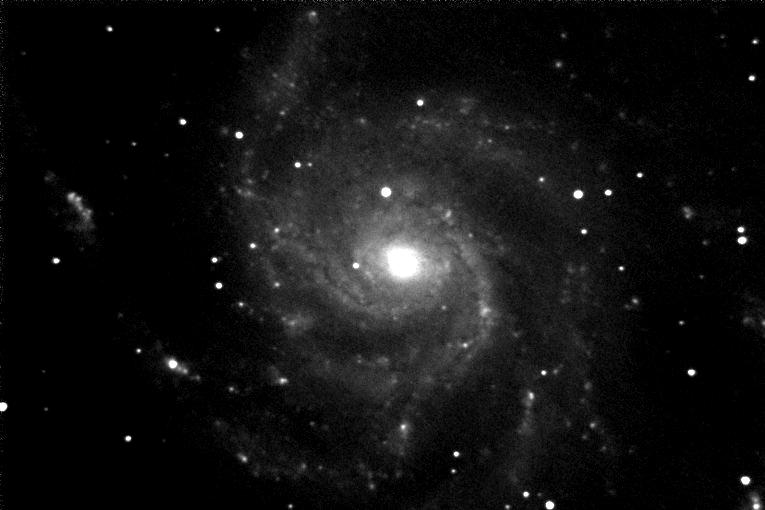 (12 Jun 2006) Twenty-five 30-second images of M101 through a clear filter were stacked to produce this
b/w image. M101, also known as the Pinwheel Galaxy, is a spiral (type Sc) located in
the constellation of Ursa Major, at a distance of about 27 million light-years. The galaxy is over
170,000 light-years across, and it contains 10's of billions of stars. The original image scale is 1.1
arcsec per pixel.
(12 Jun 2006) Twenty-five 30-second images of M101 through a clear filter were stacked to produce this
b/w image. M101, also known as the Pinwheel Galaxy, is a spiral (type Sc) located in
the constellation of Ursa Major, at a distance of about 27 million light-years. The galaxy is over
170,000 light-years across, and it contains 10's of billions of stars. The original image scale is 1.1
arcsec per pixel.
|
|
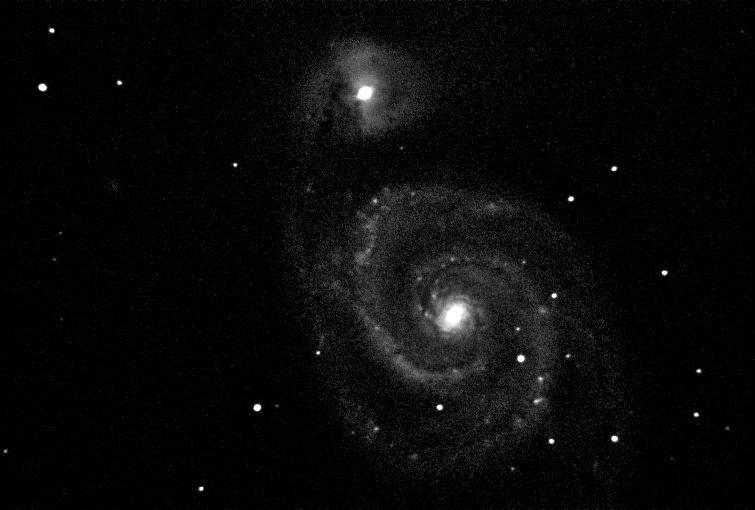 (22 May 2006) Here is another picture of M51 taken through a Red filter to produce a black-and-white image.
The image was calibrated to remove noise and vignetting.
The total exposure was 5 minutes. M51 is the Whirlpool Galaxy, in collision with its neighbor, NGC 5195. It's a spiral of type Sc and located in
the constellation of Canes Venatici, at a distance of about 37 million light-years.
The original image scale is 1.1 arcsec per pixel.
(22 May 2006) Here is another picture of M51 taken through a Red filter to produce a black-and-white image.
The image was calibrated to remove noise and vignetting.
The total exposure was 5 minutes. M51 is the Whirlpool Galaxy, in collision with its neighbor, NGC 5195. It's a spiral of type Sc and located in
the constellation of Canes Venatici, at a distance of about 37 million light-years.
The original image scale is 1.1 arcsec per pixel.
|
|
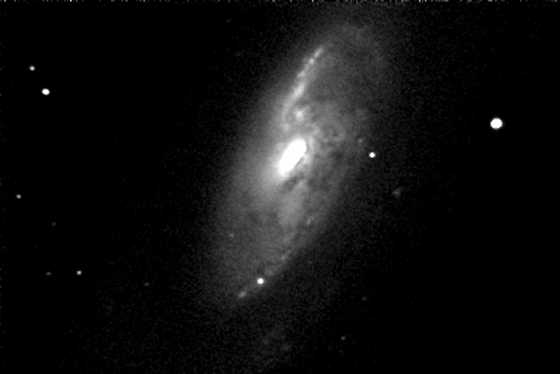 (03 May 2006) This picture of M106 is from 45 30-second
images each through the (BVRI) R filter, calibrating each to remove noise
and vignetting, and aggregating them all to improve the S/N. M106 is a barred spiral (type Sbp) located in
the constellation of Canes Venatici, at a distance of about 25 million light-years.
The original image scale is 0.98 arcsec per pixel.
(03 May 2006) This picture of M106 is from 45 30-second
images each through the (BVRI) R filter, calibrating each to remove noise
and vignetting, and aggregating them all to improve the S/N. M106 is a barred spiral (type Sbp) located in
the constellation of Canes Venatici, at a distance of about 25 million light-years.
The original image scale is 0.98 arcsec per pixel.
|
|
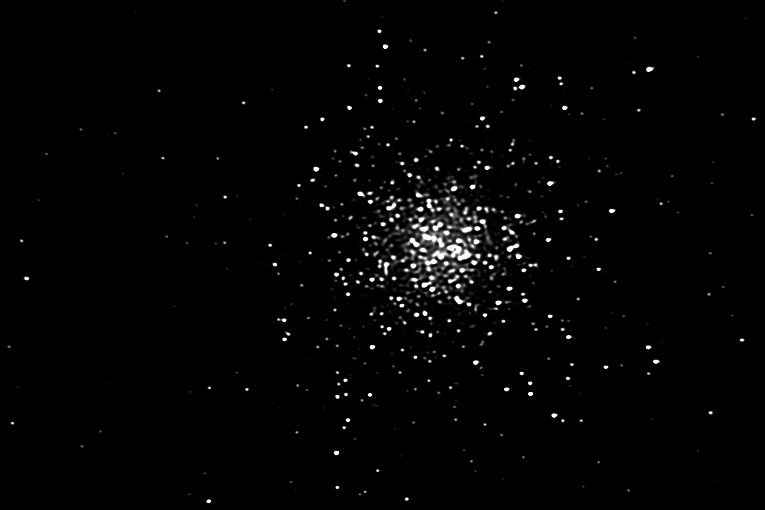 (30 Apr 2006) The great Hercules Globular Cluster - M13 - at a distance of 25,100 lightyears, with a diameter of 145 lightyears,
contains several hundred thousand stars in orbit around a common gravitational center. M13 was "discovered"
by Edmund Halley (for whom the great comet is named) in 1714. This is a composite
of five 30-second images taken through the "I" filter from the BVRI set. The images were stacked,
the contrast adjusted, and the stacked image sharpened using a deconvolution filter. The image
scale on the original is 0.98 "/pixel.
(30 Apr 2006) The great Hercules Globular Cluster - M13 - at a distance of 25,100 lightyears, with a diameter of 145 lightyears,
contains several hundred thousand stars in orbit around a common gravitational center. M13 was "discovered"
by Edmund Halley (for whom the great comet is named) in 1714. This is a composite
of five 30-second images taken through the "I" filter from the BVRI set. The images were stacked,
the contrast adjusted, and the stacked image sharpened using a deconvolution filter. The image
scale on the original is 0.98 "/pixel.
|
|
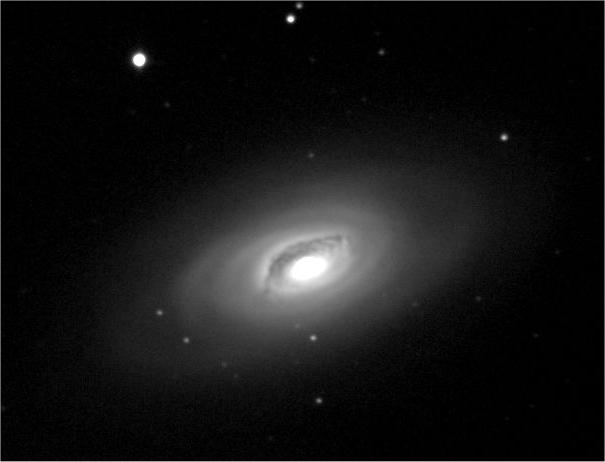 (30 Apr 2006) The Black-Eye Nebula (M 64) is a spiral galaxy some 50,000 or more light-years across, at a distance
from Earth of 19 million light years. The image is an assembly of one hundred individual 30-second unfiltered
exposures, aligned and stacked, then contrast stretched. The original scale is 0.98 "/pixel. M64 is in the constellation of
Coma Berenices. Go back.
(30 Apr 2006) The Black-Eye Nebula (M 64) is a spiral galaxy some 50,000 or more light-years across, at a distance
from Earth of 19 million light years. The image is an assembly of one hundred individual 30-second unfiltered
exposures, aligned and stacked, then contrast stretched. The original scale is 0.98 "/pixel. M64 is in the constellation of
Coma Berenices. Go back.
|
|
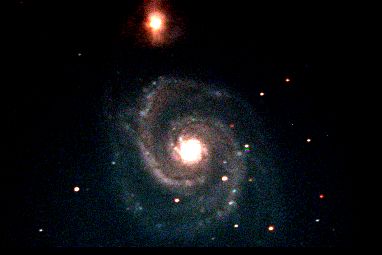 (16 Mar 2006) This false-color image of M-51 renders images taken with L, V, R and I filters as an LRGB
color image. A single exposure of 30 seconds (binning = 2) in each filter has not been processed further, so the image
is rather coarse looking. The original scale is about 1.7 "/pixel. M51 (the Whirlpool) is 37 million light-years
distant, in the constellation of Canes Venatici.
(16 Mar 2006) This false-color image of M-51 renders images taken with L, V, R and I filters as an LRGB
color image. A single exposure of 30 seconds (binning = 2) in each filter has not been processed further, so the image
is rather coarse looking. The original scale is about 1.7 "/pixel. M51 (the Whirlpool) is 37 million light-years
distant, in the constellation of Canes Venatici.
|
|
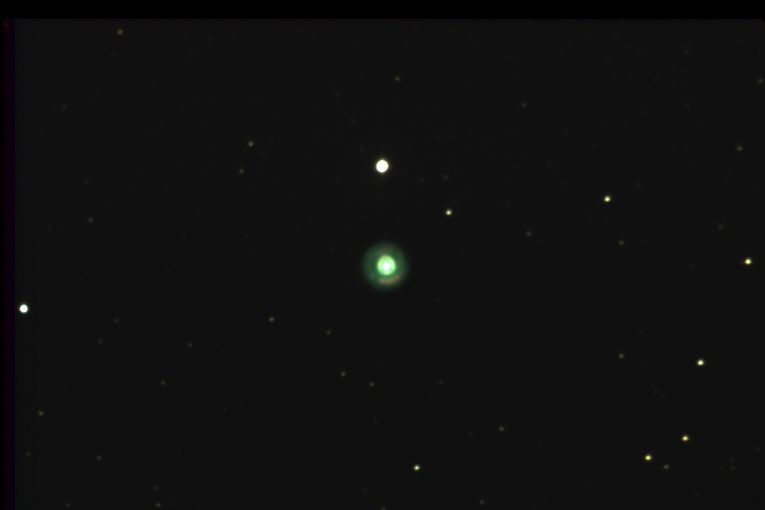 (22 Feb 2006) This is a picture of the Clown Nebula. This RGB composite is made up of eleven
exposures of 30 seconds each (5-1/2 minutes each color), with noise removed and flattened. This planetary
nebula in Gemini (NGC 2392) was discovered by William Herschel in 1787. It's at a distance of about
3,000 light-years. The original scale is 1.0 "/pixel.
(22 Feb 2006) This is a picture of the Clown Nebula. This RGB composite is made up of eleven
exposures of 30 seconds each (5-1/2 minutes each color), with noise removed and flattened. This planetary
nebula in Gemini (NGC 2392) was discovered by William Herschel in 1787. It's at a distance of about
3,000 light-years. The original scale is 1.0 "/pixel.
|
|
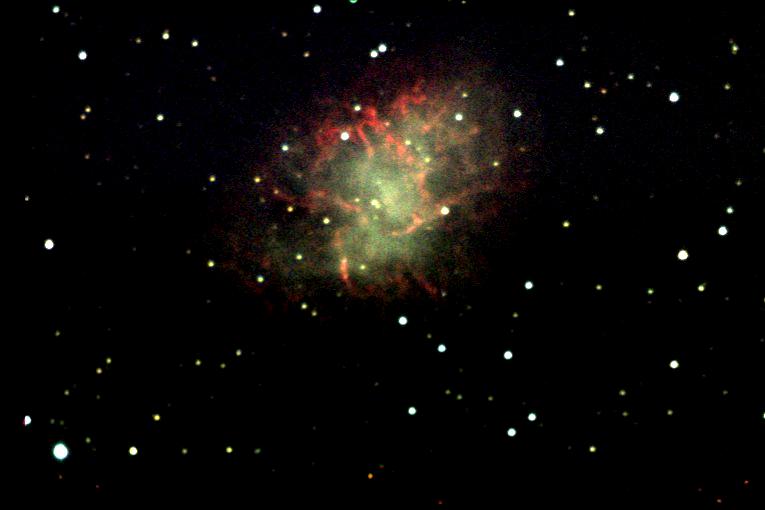 (22 Feb 2006) This ten-minute exposure of the Crab Nebula was made from twenty 30-second images each
through red, green and blue filters (10 minutes each filter), calibrating and flat-fielding each to
remove noise and vignetting, and combining each set of colors to improved the S/N. Then the RGB
images were color combined. M1 is a remnant of a supernova that was observed in the year 1054 AD.
It's about 6,300 light-years from Earth. Original scale is 1.0 arcsec per pixel.
(22 Feb 2006) This ten-minute exposure of the Crab Nebula was made from twenty 30-second images each
through red, green and blue filters (10 minutes each filter), calibrating and flat-fielding each to
remove noise and vignetting, and combining each set of colors to improved the S/N. Then the RGB
images were color combined. M1 is a remnant of a supernova that was observed in the year 1054 AD.
It's about 6,300 light-years from Earth. Original scale is 1.0 arcsec per pixel.
|
|
 (09 Feb 2006) This pretty picture of NGC 2903 was made by shooting 25 30-second
images each through red, green and blue filters, calibrating each to remove noise
and vignetting, and combining each set of colors to improved the S/N. Then the
RGB images were color combined. NGC 2903 is a barred spiral (type Sb) located in
the constellation of Leo, and is about 31 million light-years away (some report
only 21 mly). Original scale is 1.0 arcsec per pixel. Go back.
(09 Feb 2006) This pretty picture of NGC 2903 was made by shooting 25 30-second
images each through red, green and blue filters, calibrating each to remove noise
and vignetting, and combining each set of colors to improved the S/N. Then the
RGB images were color combined. NGC 2903 is a barred spiral (type Sb) located in
the constellation of Leo, and is about 31 million light-years away (some report
only 21 mly). Original scale is 1.0 arcsec per pixel. Go back.
|
|
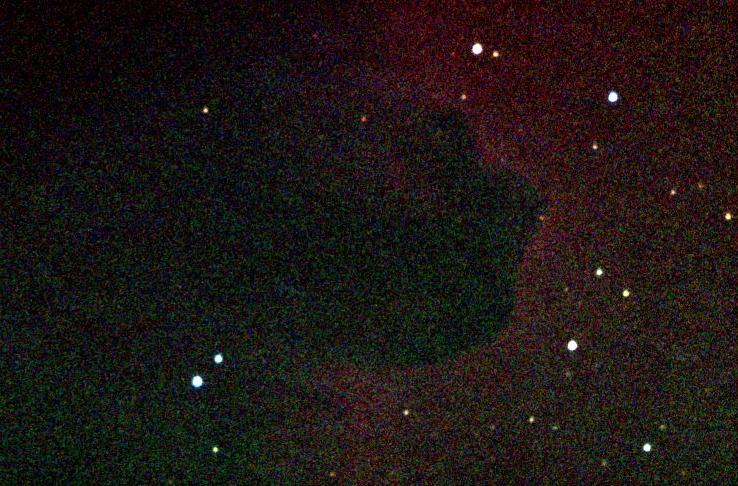 (09 Feb 2006) Barnard 33, the Horsehead Nebula, situated at a distance of 1600
light-years, is a dark globule of dust and non-luminous gas, obscuring the light
coming from IC 434 behind it. Twenty exposures of 30 seconds each were calibrated
and combined as described above. Clearly visible here, this object requires much
longer exposure time.
(09 Feb 2006) Barnard 33, the Horsehead Nebula, situated at a distance of 1600
light-years, is a dark globule of dust and non-luminous gas, obscuring the light
coming from IC 434 behind it. Twenty exposures of 30 seconds each were calibrated
and combined as described above. Clearly visible here, this object requires much
longer exposure time.
|
|
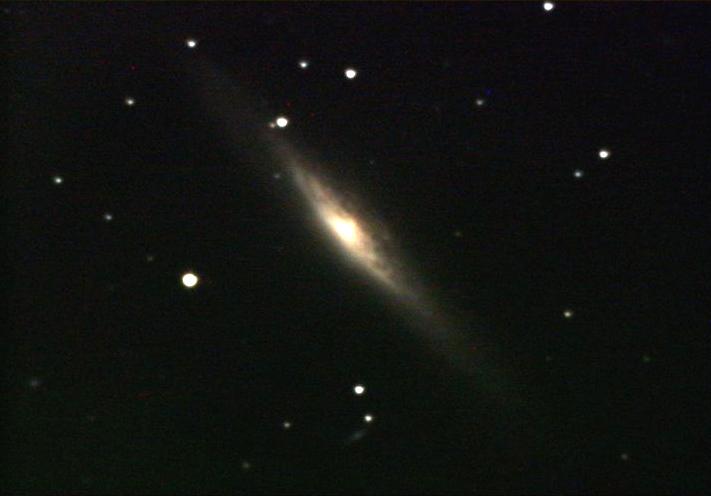 (28 Jan 2005) NGC 2683 is an Sb-type spiral galaxy located in the constellation of
Lynx, at a distance estimated to be at least 16 million light years. Just above the
bottom center edge, close to the two brighter foreground stars, is another much
more distant galaxy. This LRGB image consists of 40 unfiltered images of 20
seconds each, and 25 red-, green- and blue-filtered images of 30 seconds each.
Images were calibrated, aligned, stacked and color-combined in MaxIm DL/CCD. The
original image scale is 1.0 arcseconds per pixel.
(28 Jan 2005) NGC 2683 is an Sb-type spiral galaxy located in the constellation of
Lynx, at a distance estimated to be at least 16 million light years. Just above the
bottom center edge, close to the two brighter foreground stars, is another much
more distant galaxy. This LRGB image consists of 40 unfiltered images of 20
seconds each, and 25 red-, green- and blue-filtered images of 30 seconds each.
Images were calibrated, aligned, stacked and color-combined in MaxIm DL/CCD. The
original image scale is 1.0 arcseconds per pixel.
|
|
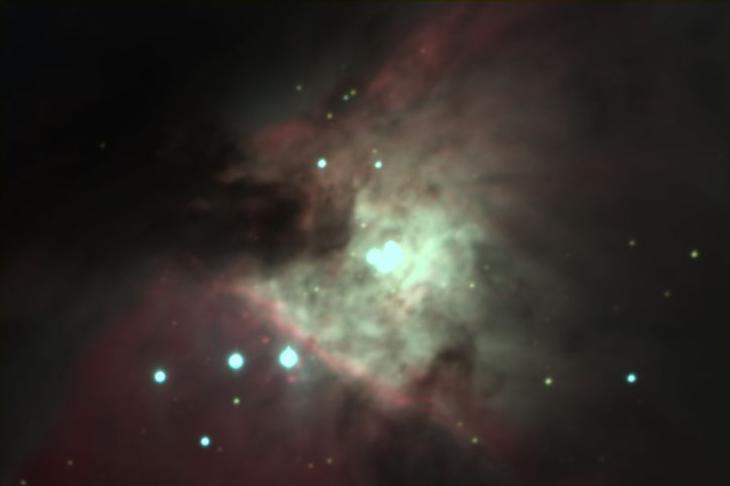 (27 Jan 2006) This image of the Orion Nebula is a composite of seventy-five images
at 10 second exposures, with an ST7-XME, 25 of each were through R, G and B filters.
All images were individually calibrated, then aligned and stacked, and finally
combined into a color image using MaxIm DL/CCD.
(27 Jan 2006) This image of the Orion Nebula is a composite of seventy-five images
at 10 second exposures, with an ST7-XME, 25 of each were through R, G and B filters.
All images were individually calibrated, then aligned and stacked, and finally
combined into a color image using MaxIm DL/CCD.
|
|
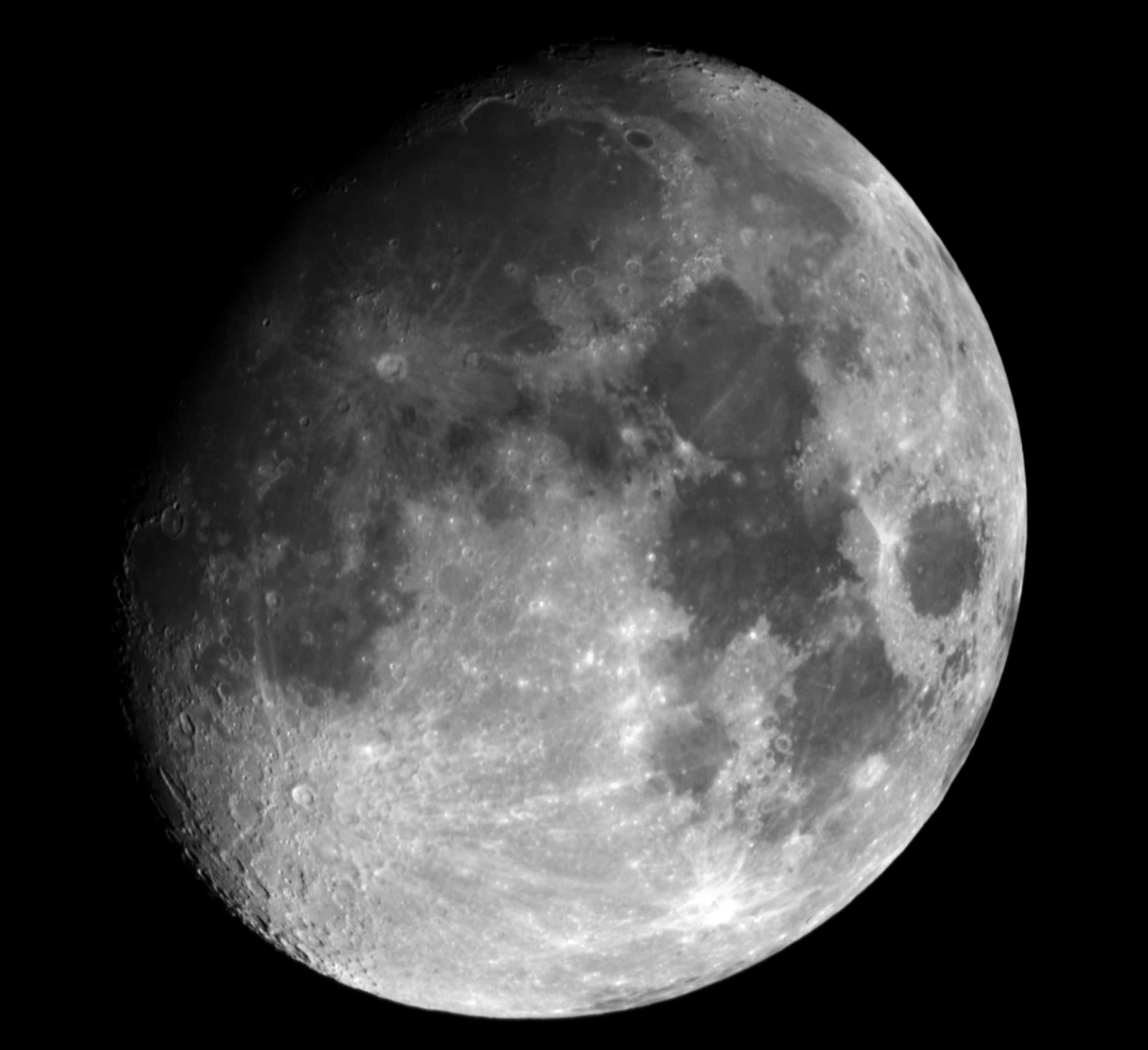 (13 Nov 2005) Twenty-three webcam images (ToUCam Pro) were captured over the course
of 45 minutes, using the 12-inch SCT at f/6.3 and the video camera interface in
MaxIm DL/CCD. Each mosaic frame consists of ten 1/25th-second exposures that were
stacked to produce a single frame. Later, these were mosaicked with MaxIm to
produce the whole image of the Moon.
(13 Nov 2005) Twenty-three webcam images (ToUCam Pro) were captured over the course
of 45 minutes, using the 12-inch SCT at f/6.3 and the video camera interface in
MaxIm DL/CCD. Each mosaic frame consists of ten 1/25th-second exposures that were
stacked to produce a single frame. Later, these were mosaicked with MaxIm to
produce the whole image of the Moon.
|
|
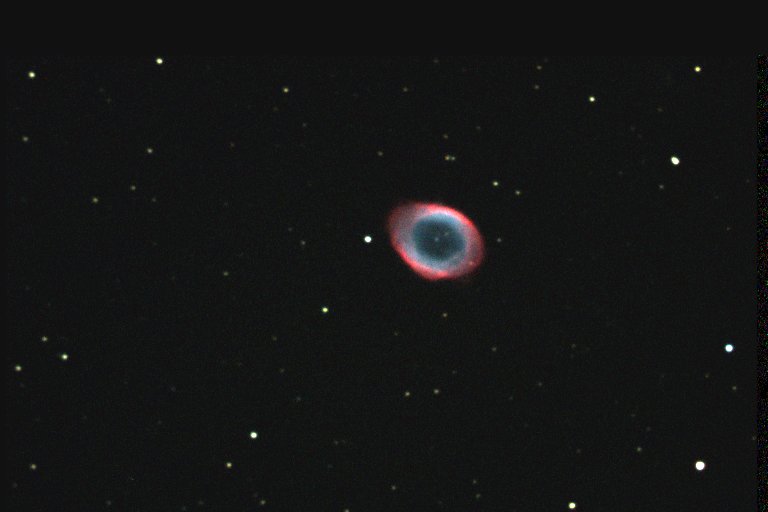 (17 Jun 2005) This composite color image of the Ring Nebula (M57) was made from
three 30-second RGB-filtered Meade Pictor 416XTE CCD images, using MaxIm DL/CCD.
The focal length is 2129 mm (f/7.0), and the original image scale is
0.87 "/pixel.
(17 Jun 2005) This composite color image of the Ring Nebula (M57) was made from
three 30-second RGB-filtered Meade Pictor 416XTE CCD images, using MaxIm DL/CCD.
The focal length is 2129 mm (f/7.0), and the original image scale is
0.87 "/pixel.
|
|
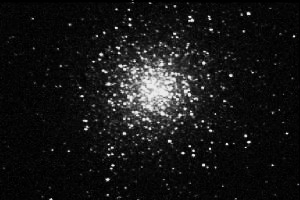 (17 Jun 2005) A single frame CCD 20-second image of M13 (Red filter). Original image
scale is 0.87 "/pixel.
(17 Jun 2005) A single frame CCD 20-second image of M13 (Red filter). Original image
scale is 0.87 "/pixel.
|
|
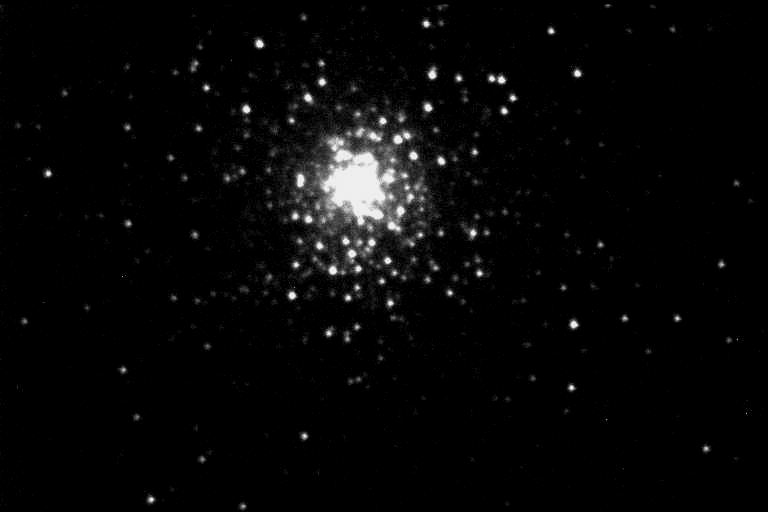 (6 Oct 2004) A single 6-second CCD image of M15 (Red filter); with an original image
scale of 0.57 "/pixel (f/10.6).
(6 Oct 2004) A single 6-second CCD image of M15 (Red filter); with an original image
scale of 0.57 "/pixel (f/10.6).
|
|
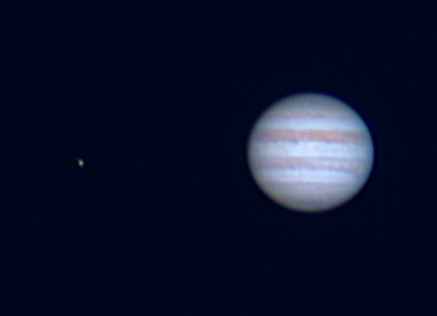 (28 Apr 2004) This image of Jupiter and Io was made from a webcam stream of 450 frames
of 1/25th second exposures each at 15 fps. About 150 of the sharpest frames were
aligned, stacked and processed in RegiStax.
(28 Apr 2004) This image of Jupiter and Io was made from a webcam stream of 450 frames
of 1/25th second exposures each at 15 fps. About 150 of the sharpest frames were
aligned, stacked and processed in RegiStax.
|
|
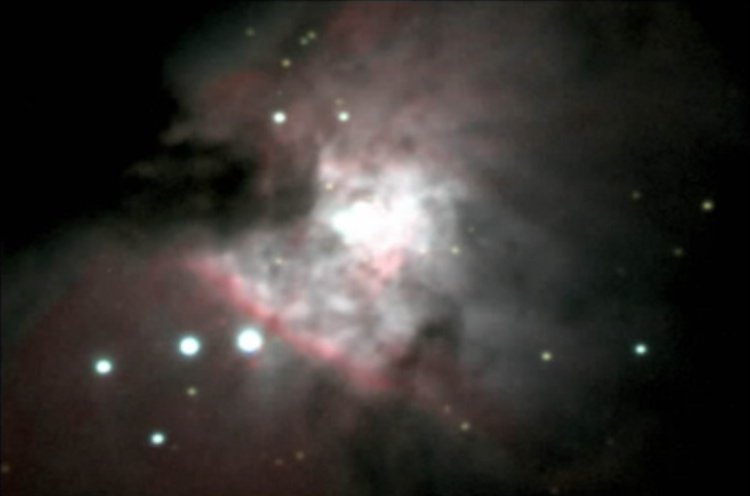 (06 Dec 2004) One each of R, G and B 10 second images were taken with the Meade Pictor 416XTE CCD
camera and merged later in Paint Shop Pro. The original image scale is approximately
0.6 "/pixel.
(06 Dec 2004) One each of R, G and B 10 second images were taken with the Meade Pictor 416XTE CCD
camera and merged later in Paint Shop Pro. The original image scale is approximately
0.6 "/pixel.
|
|
 (15 May 2004) An f/20 webcam image of Jupiter, taken with a ToUCam Pro webcam and a 2x Barlow --
aligned, stacked and finished in RegiStax.
(15 May 2004) An f/20 webcam image of Jupiter, taken with a ToUCam Pro webcam and a 2x Barlow --
aligned, stacked and finished in RegiStax.
|
|
 (27 Aug 2003) The best of the best images of Mars, during the great August 2003 opposition.
It was taken with a ToUCam Pro webcam and a 2x Barlow at f/20, and aligned, stacked and
finished in RegiStax.
(27 Aug 2003) The best of the best images of Mars, during the great August 2003 opposition.
It was taken with a ToUCam Pro webcam and a 2x Barlow at f/20, and aligned, stacked and
finished in RegiStax.
|
|
 (18-29 Aug 2003) A montage of my best pictures of Mars using a webcam, stacking and processing
about three hundred frames in each image using Registax.
(18-29 Aug 2003) A montage of my best pictures of Mars using a webcam, stacking and processing
about three hundred frames in each image using Registax.
|
|
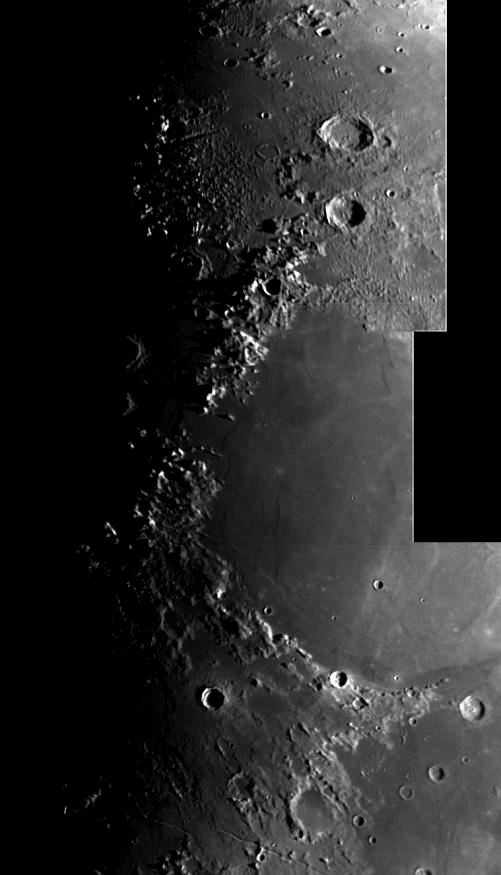 (14 Sep 2002) This is a mosaic of three single CCD images of the moon. The image covers the
terminator from the craters Sheepshanks in the north to Julius Caesar in the
south.
(14 Sep 2002) This is a mosaic of three single CCD images of the moon. The image covers the
terminator from the craters Sheepshanks in the north to Julius Caesar in the
south.
|

![]()